Spectra Engineering MXDR4V MXDR/ATLAS 4500 BASE STATION UHF User Manual IP25 Data Router Technical Manual
Spectra Engineering PTY LTD MXDR/ATLAS 4500 BASE STATION UHF IP25 Data Router Technical Manual
Technical Manual
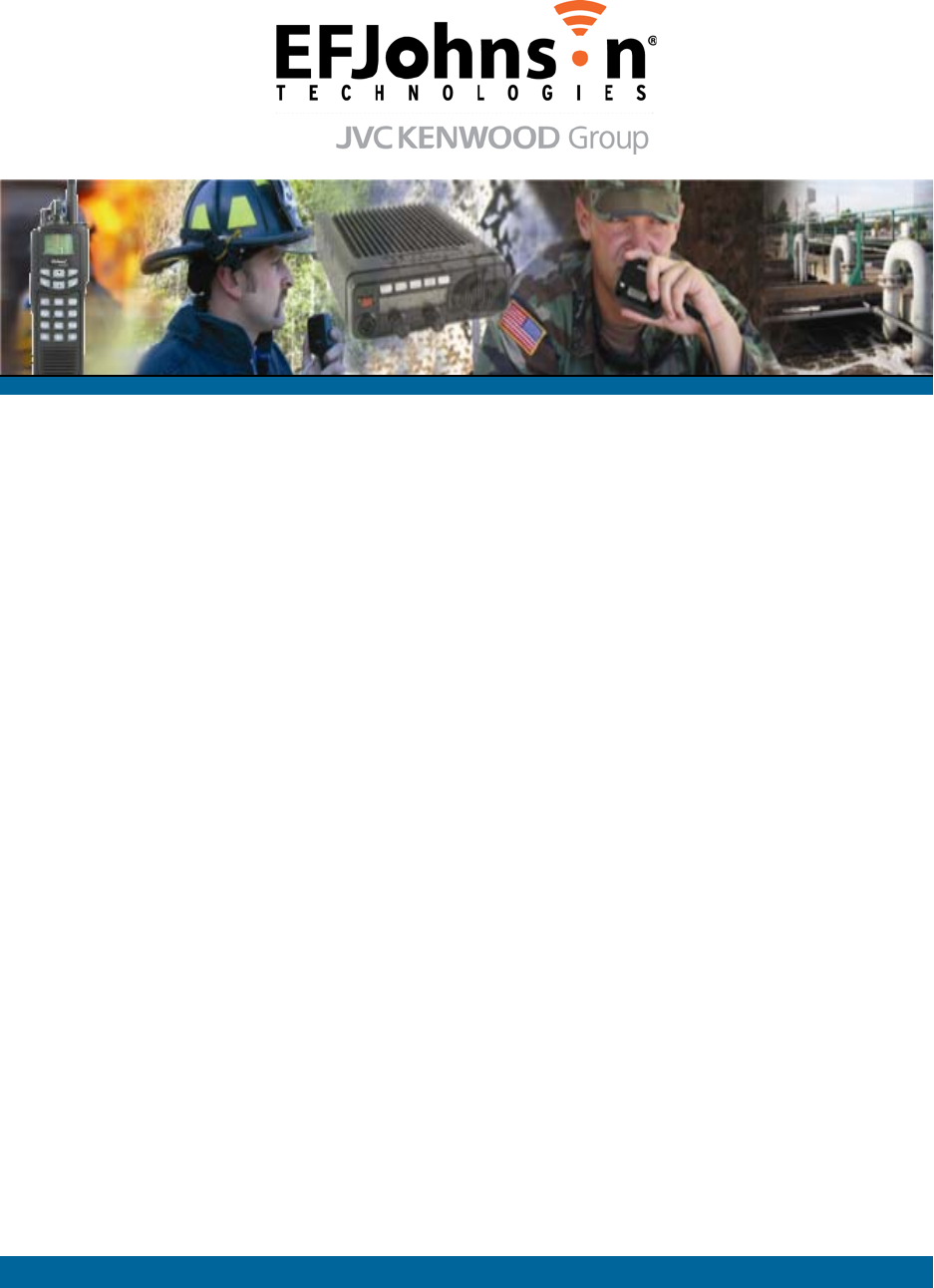
ATLAS® 4500
Multimode Station
Technical Manual
.
December 2016
Copyright © 2016 by EF Johnson Technologies, Inc.
The EFJohnson Technologies logo and StarGate are trademarks of EF Johnson Technologies, Inc. ATLAS
is a registered trademark of EFJohnson Technologies. All other company and/or product names used in this
manual are trademarks and/or registered trademarks of their respective manufacturers.
Information in this manual is subject to change without notice.
ATLAS 4500 Multimode Station Technical Manual
December 2016

ATLAS 4500 Multimode Station Technical Manual December 2016 i
Section 1 - Introduction 1-1
Using This Manual . . . . . . . . . . . . . . . . . . . . . . . . . . . . . . . . . . . . . . . . . . . . . . . . . . . . . . . . . . . . . . 1-1
Audience. . . . . . . . . . . . . . . . . . . . . . . . . . . . . . . . . . . . . . . . . . . . . . . . . . . . . . . . . . . . . . . . . . 1-1
Manual Organization. . . . . . . . . . . . . . . . . . . . . . . . . . . . . . . . . . . . . . . . . . . . . . . . . . . . . . . . . 1-1
Safety Information . . . . . . . . . . . . . . . . . . . . . . . . . . . . . . . . . . . . . . . . . . . . . . . . . . . . . . . . . . . . . . 1-2
Safety Precautions . . . . . . . . . . . . . . . . . . . . . . . . . . . . . . . . . . . . . . . . . . . . . . . . . . . . . . . . . . 1-2
Hazardous Substances. . . . . . . . . . . . . . . . . . . . . . . . . . . . . . . . . . . . . . . . . . . . . . . . . . . . . . . 1-2
Warnings and Cautions. . . . . . . . . . . . . . . . . . . . . . . . . . . . . . . . . . . . . . . . . . . . . . . . . . . . . . . 1-3
Regulatory Information . . . . . . . . . . . . . . . . . . . . . . . . . . . . . . . . . . . . . . . . . . . . . . . . . . . . . . . . . . 1-3
FCC Part 15.19 Warning Statement . . . . . . . . . . . . . . . . . . . . . . . . . . . . . . . . . . . . . . . . . . . . . 1-3
FCC Part 15.21 Warning Statement . . . . . . . . . . . . . . . . . . . . . . . . . . . . . . . . . . . . . . . . . . . . . 1-4
FCC Part 15.105(b) Warning Statement. . . . . . . . . . . . . . . . . . . . . . . . . . . . . . . . . . . . . . . . . . 1-4
IC RSS-GEN, Sec 8.4 Warning Statement . . . . . . . . . . . . . . . . . . . . . . . . . . . . . . . . . . . . . . . . 1-5
IC RSS-GEN, Sec 8.3 Warning Statement . . . . . . . . . . . . . . . . . . . . . . . . . . . . . . . . . . . . . . . . 1-6
IC RSS-102, Sec 2.6 Warning Statements . . . . . . . . . . . . . . . . . . . . . . . . . . . . . . . . . . . . . . . . 1-6
Section 2 - Product Overview 2-1
Functional Description. . . . . . . . . . . . . . . . . . . . . . . . . . . . . . . . . . . . . . . . . . . . . . . . . . . . . . . . . . . 2-1
Architecture. . . . . . . . . . . . . . . . . . . . . . . . . . . . . . . . . . . . . . . . . . . . . . . . . . . . . . . . . . . . . . . . 2-2
Usability and Maintainability . . . . . . . . . . . . . . . . . . . . . . . . . . . . . . . . . . . . . . . . . . . . . . . . . . . 2-2
Design and Performance . . . . . . . . . . . . . . . . . . . . . . . . . . . . . . . . . . . . . . . . . . . . . . . . . . . . . 2-2
Hardware Description . . . . . . . . . . . . . . . . . . . . . . . . . . . . . . . . . . . . . . . . . . . . . . . . . . . . . . . . . . . 2-3
Block Diagram. . . . . . . . . . . . . . . . . . . . . . . . . . . . . . . . . . . . . . . . . . . . . . . . . . . . . . . . . . . . . . 2-3
Front Panel Indicator LEDs. . . . . . . . . . . . . . . . . . . . . . . . . . . . . . . . . . . . . . . . . . . . . . . . . . . . 2-4
Rear Panel Connectors. . . . . . . . . . . . . . . . . . . . . . . . . . . . . . . . . . . . . . . . . . . . . . . . . . . . . . . 2-5
Software Description . . . . . . . . . . . . . . . . . . . . . . . . . . . . . . . . . . . . . . . . . . . . . . . . . . . . . . . . . . . . 2-6
Specifications . . . . . . . . . . . . . . . . . . . . . . . . . . . . . . . . . . . . . . . . . . . . . . . . . . . . . . . . . . . . . . . . . . 2-6
Section 3 - Installation and Configuration 3-1
ATLAS 4500 Multimode Station Technical Manual
December 2016

ii ATLAS 4500 Multimode Station Technical Manual December 2016
Table of Contents (continued)
Rack Installation. . . . . . . . . . . . . . . . . . . . . . . . . . . . . . . . . . . . . . . . . . . . . . . . . . . . . . . . . . . . . . . . 3-1
Connections . . . . . . . . . . . . . . . . . . . . . . . . . . . . . . . . . . . . . . . . . . . . . . . . . . . . . . . . . . . . . . . . . . . 3-1
Initial Configuration . . . . . . . . . . . . . . . . . . . . . . . . . . . . . . . . . . . . . . . . . . . . . . . . . . . . . . . . . . . . . 3-1
Section 4 - Alignment 4-1
Section 5 - Maintenance 5-1
Software Updates . . . . . . . . . . . . . . . . . . . . . . . . . . . . . . . . . . . . . . . . . . . . . . . . . . . . . . . . . . . . . . . 5-1
Section 6 - Technical Support and Service 6-1
Contacting EFJohnson . . . . . . . . . . . . . . . . . . . . . . . . . . . . . . . . . . . . . . . . . . . . . . . . . . . . . . . . . . 6-1
Gather Information Before Calling EFJohnson . . . . . . . . . . . . . . . . . . . . . . . . . . . . . . . . . . . . . 6-1
Contact Information. . . . . . . . . . . . . . . . . . . . . . . . . . . . . . . . . . . . . . . . . . . . . . . . . . . . . . . . . . 6-1
Product Warranty and Repair . . . . . . . . . . . . . . . . . . . . . . . . . . . . . . . . . . . . . . . . . . . . . . . . . . . . . 6-2
Online Product Registration . . . . . . . . . . . . . . . . . . . . . . . . . . . . . . . . . . . . . . . . . . . . . . . . . . . 6-3
Returns for Repairs . . . . . . . . . . . . . . . . . . . . . . . . . . . . . . . . . . . . . . . . . . . . . . . . . . . . . . . . . . . . . 6-3
Replacement Parts . . . . . . . . . . . . . . . . . . . . . . . . . . . . . . . . . . . . . . . . . . . . . . . . . . . . . . . . . . . . . . 6-3
Internet Home Page . . . . . . . . . . . . . . . . . . . . . . . . . . . . . . . . . . . . . . . . . . . . . . . . . . . . . . . . . . . . . 6-4
Appendix A - UHF Circuit Descriptions A-1
380-520 MHz Exciter Module . . . . . . . . . . . . . . . . . . . . . . . . . . . . . . . . . . . . . . . . . . . . . . . . . . . . . . A-1
General Description . . . . . . . . . . . . . . . . . . . . . . . . . . . . . . . . . . . . . . . . . . . . . . . . . . . . . . . . . A-2
Schematic Description . . . . . . . . . . . . . . . . . . . . . . . . . . . . . . . . . . . . . . . . . . . . . . . . . . . . . . . A-2
Frequency Synthesizers . . . . . . . . . . . . . . . . . . . . . . . . . . . . . . . . . . . . . . . . . . . . . . . . . A-2
TX VCO Board. . . . . . . . . . . . . . . . . . . . . . . . . . . . . . . . . . . . . . . . . . . . . . . . . . . . . . . . . A-3
Reference Clocks . . . . . . . . . . . . . . . . . . . . . . . . . . . . . . . . . . . . . . . . . . . . . . . . . . . . . . A-3
RF Carrier Generation & Modulation. . . . . . . . . . . . . . . . . . . . . . . . . . . . . . . . . . . . . . . . A-4
RF Filter Amp Section . . . . . . . . . . . . . . . . . . . . . . . . . . . . . . . . . . . . . . . . . . . . . . . . . . . A-4
DPD Loop . . . . . . . . . . . . . . . . . . . . . . . . . . . . . . . . . . . . . . . . . . . . . . . . . . . . . . . . . . . .A-4
Exciter DC Supplies. . . . . . . . . . . . . . . . . . . . . . . . . . . . . . . . . . . . . . . . . . . . . . . . . . . . . A-5
380-520 MHz Receiver Module . . . . . . . . . . . . . . . . . . . . . . . . . . . . . . . . . . . . . . . . . . . . . . . . . . . . A-6
General Description . . . . . . . . . . . . . . . . . . . . . . . . . . . . . . . . . . . . . . . . . . . . . . . . . . . . . . . . . A-6
Schematic Description . . . . . . . . . . . . . . . . . . . . . . . . . . . . . . . . . . . . . . . . . . . . . . . . . . . . . . . A-7
Frequency Synthesizer . . . . . . . . . . . . . . . . . . . . . . . . . . . . . . . . . . . . . . . . . . . . . . . . . . A-7
RX VCO Board . . . . . . . . . . . . . . . . . . . . . . . . . . . . . . . . . . . . . . . . . . . . . . . . . . . . . . . . A-7
Reference Clock . . . . . . . . . . . . . . . . . . . . . . . . . . . . . . . . . . . . . . . . . . . . . . . . . . . . . . . A-8
ATLAS 4500 Multimode Station Technical Manual December 2016 iii
Table of Contents (continued)
Front End. . . . . . . . . . . . . . . . . . . . . . . . . . . . . . . . . . . . . . . . . . . . . . . . . . . . . . . . . . . . . A-8
90 MHz IF Section. . . . . . . . . . . . . . . . . . . . . . . . . . . . . . . . . . . . . . . . . . . . . . . . . . . . . . A-8
Receiver DC Supplies . . . . . . . . . . . . . . . . . . . . . . . . . . . . . . . . . . . . . . . . . . . . . . . . . . . A-8
380-520 MHz Power Amplifier . . . . . . . . . . . . . . . . . . . . . . . . . . . . . . . . . . . . . . . . . . . . . . . . . . . . . A-9
General Description . . . . . . . . . . . . . . . . . . . . . . . . . . . . . . . . . . . . . . . . . . . . . . . . . . . . . . . . . A-9
Schematic Description . . . . . . . . . . . . . . . . . . . . . . . . . . . . . . . . . . . . . . . . . . . . . . . . . . . . . . . A-9
General . . . . . . . . . . . . . . . . . . . . . . . . . . . . . . . . . . . . . . . . . . . . . . . . . . . . . . . . . . . . . . A-9
Attenuator . . . . . . . . . . . . . . . . . . . . . . . . . . . . . . . . . . . . . . . . . . . . . . . . . . . . . . . . . . .A-10
Driver Module . . . . . . . . . . . . . . . . . . . . . . . . . . . . . . . . . . . . . . . . . . . . . . . . . . . . . . . . A-10
Output Power Amp . . . . . . . . . . . . . . . . . . . . . . . . . . . . . . . . . . . . . . . . . . . . . . . . . . . . A-10
Power Coupler. . . . . . . . . . . . . . . . . . . . . . . . . . . . . . . . . . . . . . . . . . . . . . . . . . . . . . . . A-10
Power Detector . . . . . . . . . . . . . . . . . . . . . . . . . . . . . . . . . . . . . . . . . . . . . . . . . . . . . . . A-11
Harmonic Filter . . . . . . . . . . . . . . . . . . . . . . . . . . . . . . . . . . . . . . . . . . . . . . . . . . . . . . . A-11
PTT Power Control . . . . . . . . . . . . . . . . . . . . . . . . . . . . . . . . . . . . . . . . . . . . . . . . . . . . A-11
Auxiliary Circuits . . . . . . . . . . . . . . . . . . . . . . . . . . . . . . . . . . . . . . . . . . . . . . . . . . . . . . A-11
Controller Board. . . . . . . . . . . . . . . . . . . . . . . . . . . . . . . . . . . . . . . . . . . . . . . . . . . . . . . . . . . . . . . A-11
General Description . . . . . . . . . . . . . . . . . . . . . . . . . . . . . . . . . . . . . . . . . . . . . . . . . . . . . . . . A-12
Schematic Description . . . . . . . . . . . . . . . . . . . . . . . . . . . . . . . . . . . . . . . . . . . . . . . . . . . . . .A-12
PA Interface . . . . . . . . . . . . . . . . . . . . . . . . . . . . . . . . . . . . . . . . . . . . . . . . . . . . . . . . . . A-12
Exciter Interface. . . . . . . . . . . . . . . . . . . . . . . . . . . . . . . . . . . . . . . . . . . . . . . . . . . . . . . A-12
RX Interface. . . . . . . . . . . . . . . . . . . . . . . . . . . . . . . . . . . . . . . . . . . . . . . . . . . . . . . . . . A-13
DSP Interface . . . . . . . . . . . . . . . . . . . . . . . . . . . . . . . . . . . . . . . . . . . . . . . . . . . . . . . . A-13
Fan Control . . . . . . . . . . . . . . . . . . . . . . . . . . . . . . . . . . . . . . . . . . . . . . . . . . . . . . . . . . A-14
External Port and Serial Links . . . . . . . . . . . . . . . . . . . . . . . . . . . . . . . . . . . . . . . . . . . . A-14
Auxiliary. . . . . . . . . . . . . . . . . . . . . . . . . . . . . . . . . . . . . . . . . . . . . . . . . . . . . . . . . . . . . A-14
Firmware . . . . . . . . . . . . . . . . . . . . . . . . . . . . . . . . . . . . . . . . . . . . . . . . . . . . . . . . . . . .A-14
Audio Logic Board . . . . . . . . . . . . . . . . . . . . . . . . . . . . . . . . . . . . . . . . . . . . . . . . . . . . . . . . . . . . . A-15
General Description . . . . . . . . . . . . . . . . . . . . . . . . . . . . . . . . . . . . . . . . . . . . . . . . . . . . . . . . A-15
Schematic Description . . . . . . . . . . . . . . . . . . . . . . . . . . . . . . . . . . . . . . . . . . . . . . . . . . . . . .A-15
Power Supply . . . . . . . . . . . . . . . . . . . . . . . . . . . . . . . . . . . . . . . . . . . . . . . . . . . . . . . . . . . . . . . . . A-16
General Description . . . . . . . . . . . . . . . . . . . . . . . . . . . . . . . . . . . . . . . . . . . . . . . . . . . . . . . . A-16
Schematic Description . . . . . . . . . . . . . . . . . . . . . . . . . . . . . . . . . . . . . . . . . . . . . . . . . . . . . .A-16
Mains-to-48V PSU. . . . . . . . . . . . . . . . . . . . . . . . . . . . . . . . . . . . . . . . . . . . . . . . . . . . . A-16
Filters. . . . . . . . . . . . . . . . . . . . . . . . . . . . . . . . . . . . . . . . . . . . . . . . . . . . . . . . . . . . . . . A-16
Switch Mode DC-to-DC Convertors. . . . . . . . . . . . . . . . . . . . . . . . . . . . . . . . . . . . . . . . A-16

ATLAS 4500 Multimode Station Technical Manual December 2016 v
List of Figures
Figure Page
2.1 ATLAS 4500 Introductory View . . . . . . . . . . . . . . . . . . . . . . . . . . . . . . . . . . . . . . . . . . . . 2-2
2.2 Block Diagram . . . . . . . . . . . . . . . . . . . . . . . . . . . . . . . . . . . . . . . . . . . . . . . . . . . . . . . . . 2-3
2.3 Front Panel . . . . . . . . . . . . . . . . . . . . . . . . . . . . . . . . . . . . . . . . . . . . . . . . . . . . . . . . . . . 2-4
2.4 Rear Panel and Connectors. . . . . . . . . . . . . . . . . . . . . . . . . . . . . . . . . . . . . . . . . . . . . . . 2-5

ATLAS 4500 Multimode Station Technical Manual December 2016 vii
List of Tables
Table Page
1.1 ATLAS 4500 Antennas . . . . . . . . . . . . . . . . . . . . . . . . . . . . . . . . . . . . . . . . . . . . . . . . . . 1-4
1.2 ATLAS 4500 Antennas / Antennes . . . . . . . . . . . . . . . . . . . . . . . . . . . . . . . . . . . . . . . . . 1-6
2.1 Front Panel LEDs. . . . . . . . . . . . . . . . . . . . . . . . . . . . . . . . . . . . . . . . . . . . . . . . . . . . . . . 2-4
2.2 Rear Panel Connectors . . . . . . . . . . . . . . . . . . . . . . . . . . . . . . . . . . . . . . . . . . . . . . . . . . 2-6
2.3 General Specifications. . . . . . . . . . . . . . . . . . . . . . . . . . . . . . . . . . . . . . . . . . . . . . . . . . . 2-7
2.4 Transmitter Specifications . . . . . . . . . . . . . . . . . . . . . . . . . . . . . . . . . . . . . . . . . . . . . . . . 2-7
2.5 Receiver Specifications . . . . . . . . . . . . . . . . . . . . . . . . . . . . . . . . . . . . . . . . . . . . . . . . . . 2-8
2.6 Standards Compliance. . . . . . . . . . . . . . . . . . . . . . . . . . . . . . . . . . . . . . . . . . . . . . . . . . . 2-8
6.1 Customer Service Contact Information . . . . . . . . . . . . . . . . . . . . . . . . . . . . . . . . . . . . . . 6-2
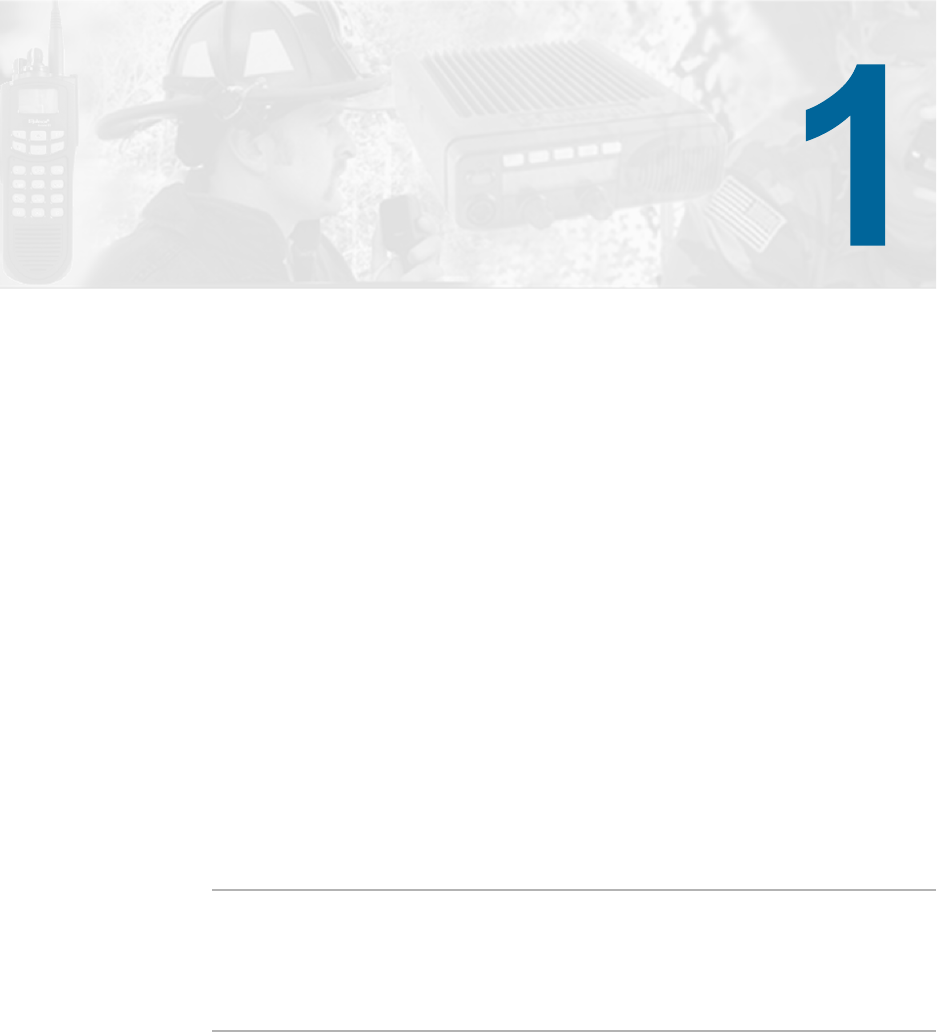
ATLAS 4500 Multimode Station Technical Manual December 2016 1-1
SECTION
Introduction
This section contains information on the following topics:
• Using This Manual
• Safety Information
• Regulatory Information
1.1 Using This Manual
This manual is the core document for information on ATLAS® 4500 Multimode
Station installation, new configuration, administration, and maintenance.
1.1.1 Audience
This manual is intended for technical support personnel, system and network
administrators, who install, configure, and maintain the ATLAS 4500.
1.1.2 Manual Organization
This product manual will help you configure and use the ATLAS 4500. This
manual is organized into sections to assist you in locating information quickly and
efficiently. It contains the following sections:
• Product Overview
• Installation and Configuration
• Alignment
• Maintenance

1-2 ATLAS 4500 Multimode Station Technical Manual December 2016
Safety Information Section 1 - Introduction
• Technical Support and Service
1.2 Safety Information
1.2.1 Safety Precautions
These safety precautions, warnings and cautions advise personnel of specific
hazards that may be encountered during the procedures contained in this document.
Control measures are required to prevent injury to personnel, and damage to
equipment and the operating environment.
Before beginning the installation or any maintenance of this equipment, personnel
are to acquaint themselves with all risk assessments relevant to the work site and
the task. They must then comply with the control measures detailed in those risk
assessments.
References covering safety regulations, health hazards and hazardous substances
are detailed under the following WARNINGS section. These are referred to in the
tasks, when encountered.
Adequate precautions must be taken to ensure that other personnel do not activate
any equipment that has been switched off for maintenance.
1.2.2 Hazardous Substances
Before using any hazardous substance or material, the user must be conversant with
the safety precautions and first aid instructions:
• On the label of the container in which it was supplied.
• On the material Safety Data Sheet.
• In any local Safety Orders and Regulations.
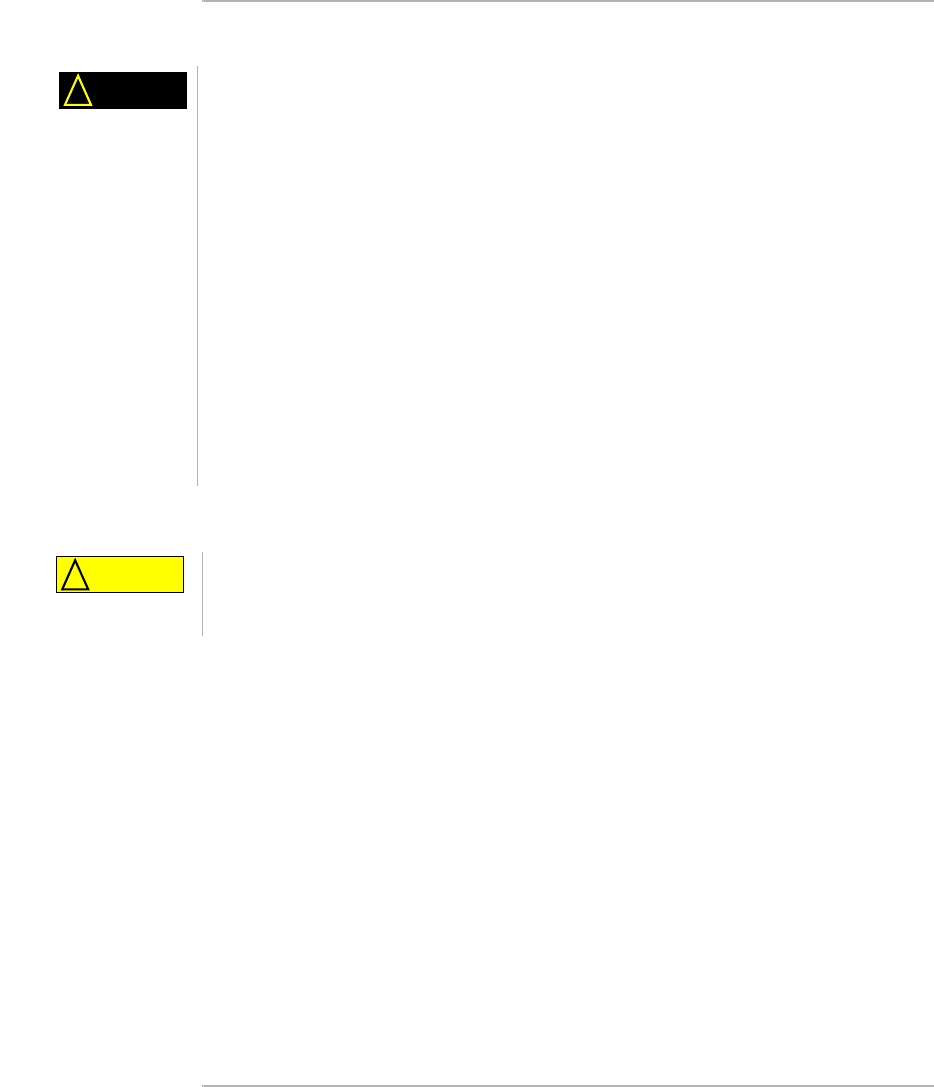
ATLAS 4500 Multimode Station Technical Manual December 2016 1-3
Regulatory Information Section 1 - Introduction
1.2.3 Warnings and Cautions
Observe all warnings and cautions when working on or around this equipment.
1.3 Regulatory Information
This section contains the following statements:
• FCC Part 15.19 Warning Statement
• FCC Part 15.21 Warning Statement
• FCC Part 15.105(b) Warning Statement
• IC RSS-GEN, Sec 8.4 Warning Statement
• IC RSS-GEN, Sec 8.3 Warning Statement
• IC RSS-102, Sec 2.6 Warning Statements
1.3.1 FCC Part 15.19 Warning Statement
This device complies with Part 15 of the FCC rules. Operation is subject to the
following two conditions:
• This device may not cause harmful interference.
• This device must accept any interference received, including interference that
may cause undesired operation.
WARNING
!
•Radio frequency radiation. A radio frequency (rf) radiation hazard exists in this equipment. To
avoid rf injury, do not touch the antenna when the transmitter is in use. Do not operate transmitter
with antenna disconnected.
•Thermal or RF burns. Do not attempt internal servicing while transmitting. Thermal or RF burns
may result from touching certain components within the power amplifier module while transmitting
or operating the transmitter.
•Shock Hazard. To minimize any possible shock hazard from an external power supply or lightning
strike, the chassis of the equipment cabinet must to be connected to an electrical safety earth
connection.
•Do not operate in an explosive atmosphere. Do not operate this equipment in the presence of
flammable gases or fumes. operation of any electrical equipment in such an environment
constitutes a definite safety hazard.
•Do not substitute parts or modify the equipment. Due to the danger of introducing additional
hazards, do not install substitute or lower voltage parts to the equipment. Return to your authorized
distributor.
•Beryllium and beryllia. Most rf power transistors and some rf power hybrids contain beryllium
oxide. Refer to the appropriate safety data sheet and/or consult your local authority for correct
disposal thereof.
CAUTION
!
Electrostatic Discharge Sensitive Devices (ESDS Devices). Observe the appropriate
precautions and procedures when working on, or in the vicinity of, this equipment to avoid
personal injury and/or damage to the equipment
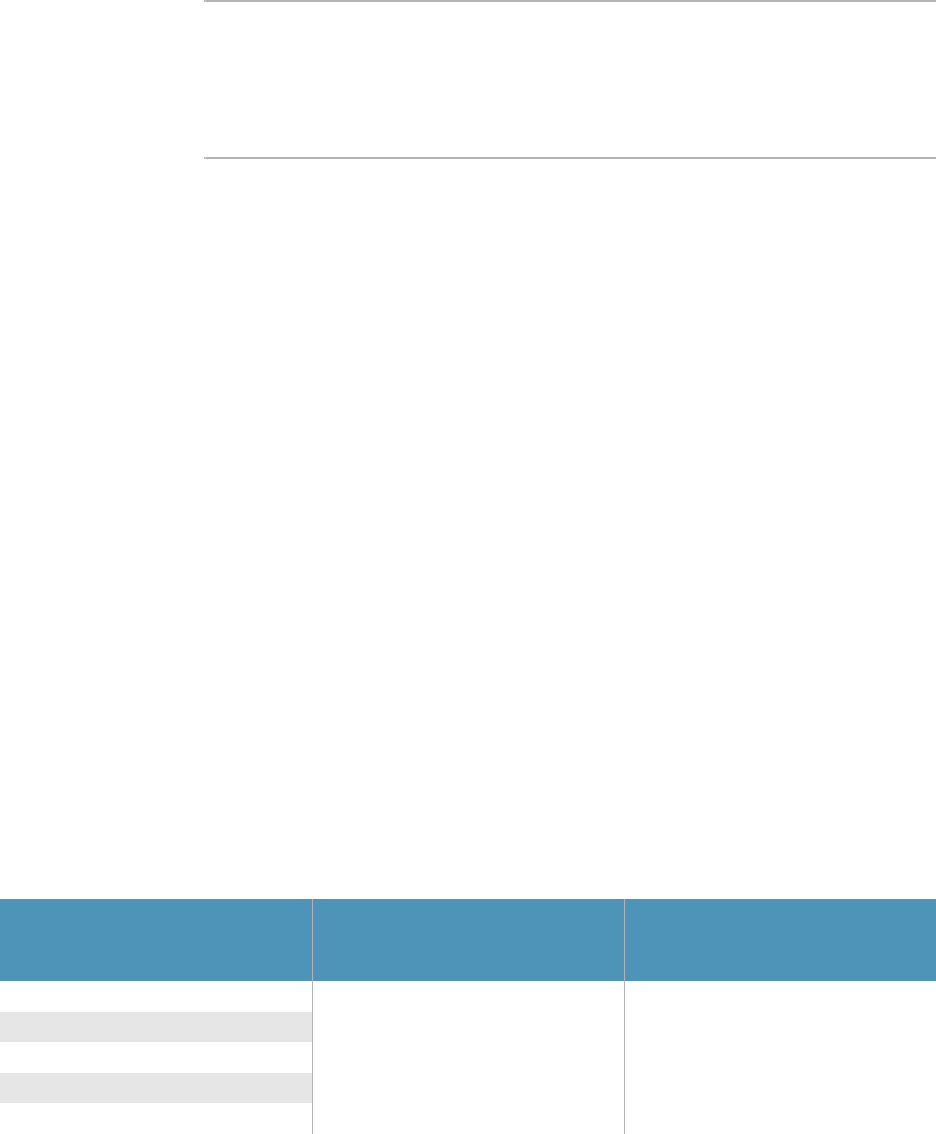
1-4 ATLAS 4500 Multimode Station Technical Manual December 2016
Regulatory Information Section 1 - Introduction
1.3.2 FCC Part 15.21 Warning Statement
The grantee is not responsible for any changes or modifications not expressly
approved by the party responsible for compliance. Such modifications could void
the user’s authority to operate the equipment.
1.3.3 FCC Part 15.105(b) Warning Statement
This equipment has been tested and found to comply with the limits for a Class B
digital device, pursuant to Part 15 of the FCC Rules. These limits are designed to
provide reasonable protection against harmful interference in a residential
installation. This equipment generates uses and can radiate radio frequency energy
and, if not installed and used in accordance with the instructions, may cause
harmful interference to radio communications. However, there is no guarantee that
interference will not occur in a particular installation. If this equipment does cause
harmful interference to radio or television reception, which can be determined by
turning the equipment off and on, the user is encouraged to try to correct the
interference by one or more of the following measures:
• Reorient or relocate the receiving antenna.
• Increase the separation between the equipment and receiver.
• Connect the equipment into an outlet on a circuit different from that to which the
receiver is connected.
• Consult the dealer or an experienced radio/TV technician for help.
• Do not operate the transmitter of a stationary radio (base station or marine radio)
when a person is within 14.89 feet (4.54 meters) of the antenna.
• The ATLAS 4500 has been approved to operate with the antenna types listed in
Table 1.1 with the maximum permissible gain and required antenna impedance
for each antenna type indicated. Antenna types not included in this list, having a
gain greater than the maximum gain indicated for that type, are strictly
prohibited for use with this device.
Table 1.1 ATLAS 4500 Antennas
Antenna Manufacturer
and Model Number
Maximum Permissible
Antenna Gain
[dBd] Required Impedance
[]
Telewave ANT395F6 6 50
Telewave ANT415F6
Telewave ANT440F6
Telewave ANT450F6
Telewave ANT500F6

ATLAS 4500 Multimode Station Technical Manual December 2016 1-5
Regulatory Information Section 1 - Introduction
1.3.4 IC RSS-GEN, Sec 8.4 Warning Statement
English
This device complies with Industry Canada license-exempt RSS standard.
Operation is subject to the following two conditions:
• This device may not cause interference.
• This device must accept any interference, including interference that may cause
undesired operation of the device.
Français
Le présent appareil est conforme aux CNR d'Industrie Canada applicables aux
appareils radio exempts de licence. L'exploitation est autorisée aux deux conditions
suivantes:
• L'appareil ne doit pas produire de brouillage.
• L'utilisateur de l'appareil doit accepter tout brouillage radioélectrique subi, même
si le brouillage est susceptible d'en compromettre le fonctionnement.
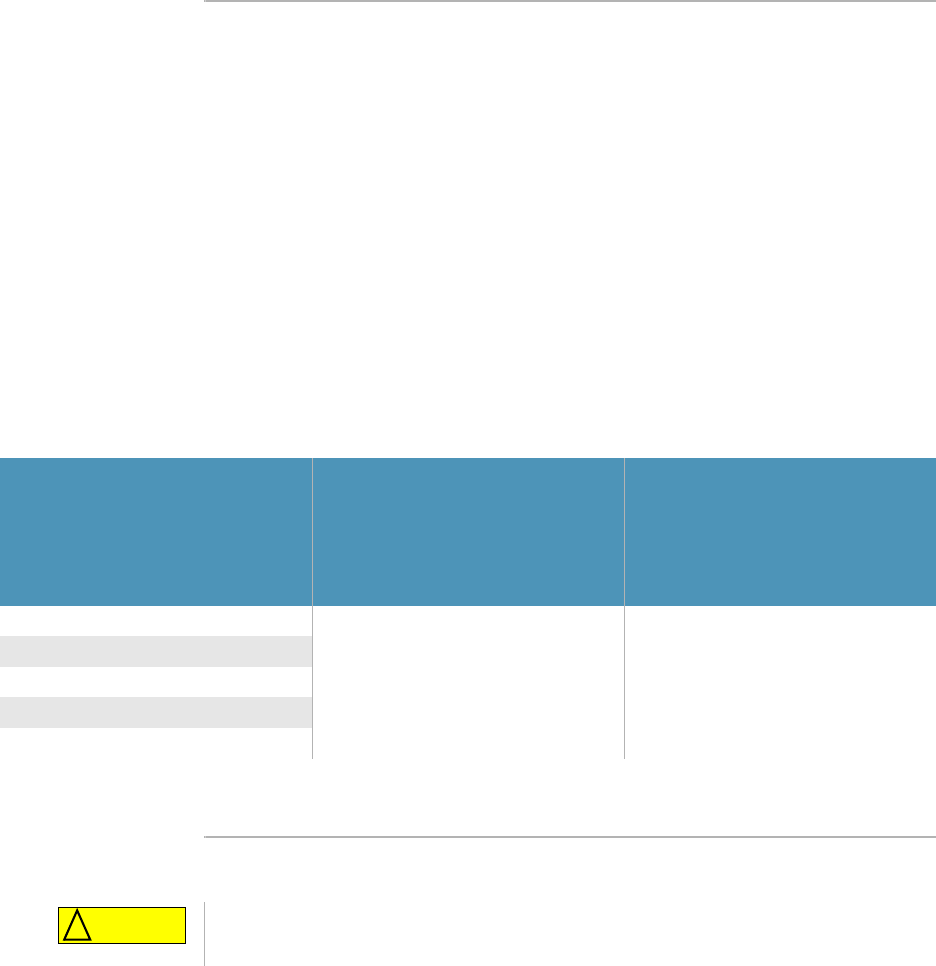
1-6 ATLAS 4500 Multimode Station Technical Manual December 2016
Regulatory Information Section 1 - Introduction
1.3.5 IC RSS-GEN, Sec 8.3 Warning Statement
English
The ATLAS 4500 has been approved by Industry Canada to operate with the
antenna types listed in Table 1.2 with the maximum permissible gain and required
antenna impedance for each antenna type indicated. Antenna types not included in
this list, having a gain greater than the maximum gain indicated for that type, are
strictly prohibited for use with this device.
Français
Le ATLAS 4500 a été approuvé par Industrie Canada pour fonctionner avec les
types d'antenne énumérés en Table 1.2 et ayant un gain admissible maximal et
l'impédance requise pour chaque type d'antenne. Les types d'antenne non inclus
dans cette liste, ou dont le gain est supérieur au gain maximal indiqué, sont
strictement interdits pour l'exploitation de cet émetteur.
1.3.6 IC RSS-102, Sec 2.6 Warning Statements
English
Proper operation of this repeater under normal conditions results in user exposure
to RF energy below standard acceptable limits.
• Do not allow the antenna to touch or come in very close proximity with the eyes,
face, or any exposed body parts while the repeater is transmitting.
• Do not operate the transmitter of a stationary radio (base station or marine radio)
when a person is within 14.89 feet (4.54 meters) of the antenna.
• Do not operate the repeater in explosive or flammable atmospheres. The
transmitted repeater energy could trigger blasting caps or cause an explosion.
Table 1.2 ATLAS 4500 Antennas / Antennes
Antenna Manufacturer
and Model Number
Antenne Fabricant et numéro de
modèle
Maximum Permissible
Antenna Gain
Maximum admissible Gain
d'antenne
[dBd]
Required Impedance
Impédance requise
[]
Telewave ANT395F6 6 50
Telewave ANT415F6
Telewave ANT440F6
Telewave ANT450F6
Telewave ANT500F6
CAUTION
!
This repeater emits radio frequency (RF) energy when transmitting. Make sure to observe all RF
energy exposure standards when installing, testing, repairing, and operating this radio equipment.
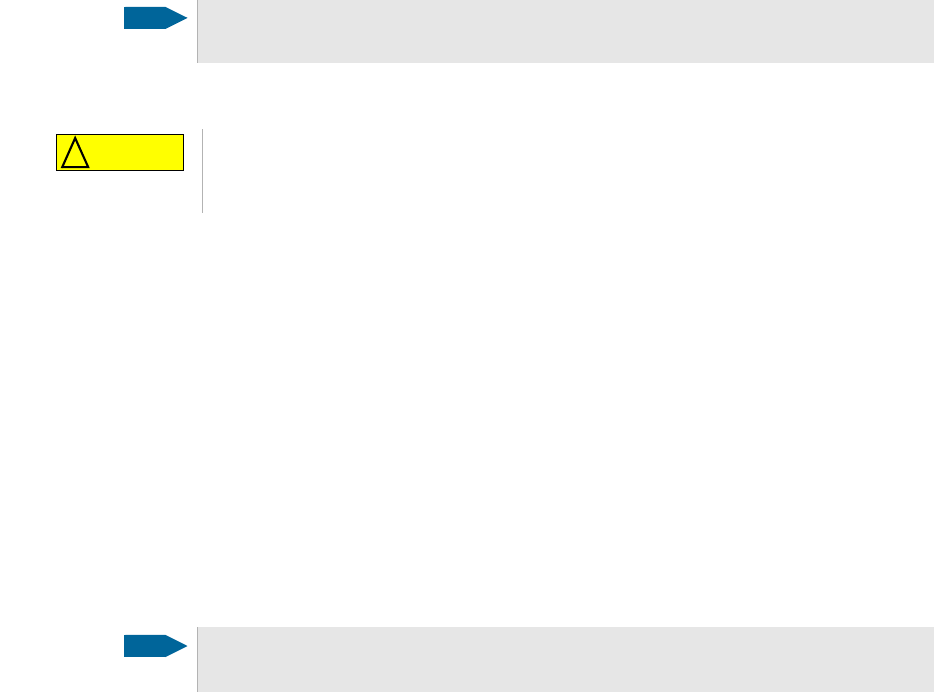
ATLAS 4500 Multimode Station Technical Manual December 2016 1-7
Regulatory Information Section 1 - Introduction
• Do not operate the repeater without the proper antenna installed.
• Do not allow children to operate transmitter equipped repeater equipment.
Français
Le bon fonctionnement de ce répéteur dans des conditions normales entraîne
l'exposition de l'utilisateur à l'énergie RF en dessous des limites du standard
acceptables.
• Ne pas laisser l'antenne entrer en contact ou à proximité des yeux, du visage ou
des parties du corps exposées lorsque le répéteur transmet.
• Ne pas faire fonctionner l'émetteur d'une radio fixe (station de base ou radio
marine) quand une personne est dans les 14.89 pieds (4.54 mètres) de l'antenne.
• Ne pas faire fonctionner le répéteur dans des atmosphères explosives ou
inflammables. L'énergie du répéteur qui transmet pourrait déclencher des
détonations ou provoquer une explosion.
• Ne pas faire fonctionner le répéteur sans l'antenne appropriée installée.
•Ne pas laisser les enfants utiliser l'émetteur équipé du matériel de répéteur.
NOTE
The preceding warning list is not intended to include all hazards that may be encountered when
using this repeater.
CAUTION
!
Ce répéteur émet des fréquences radio (RF) lors de la transmission. Assurez-vous de respecter
toutes les normes d' exposition à l'énergie RF lors de l'installation, les essais, la réparation et
l'utilisation de ce matériel radio.
NOTE
La liste d’avertissement précédente ne vise pas à inclure tous les dangers qui peuvent survenir
lorsque vous utilisez ce répéteur.

ATLAS 4500 Multimode Station Technical Manual December 2016 2-1
SECTION
Product Overview
This chapter contains the following sections:
• Functional Description
• Hardware Description
• Software Description
• Specifications
2.1 Functional Description
The ATLAS 4500 (Figure 2.1) is a fully software-definable IP-based linear base
station that operates in P25 Phase 1 and P25 Phase 2. It has both analog and P25
mixed-mode capabilities. It is available in a range of frequency bands including
VHF, UHF, and 700/800 MHz.
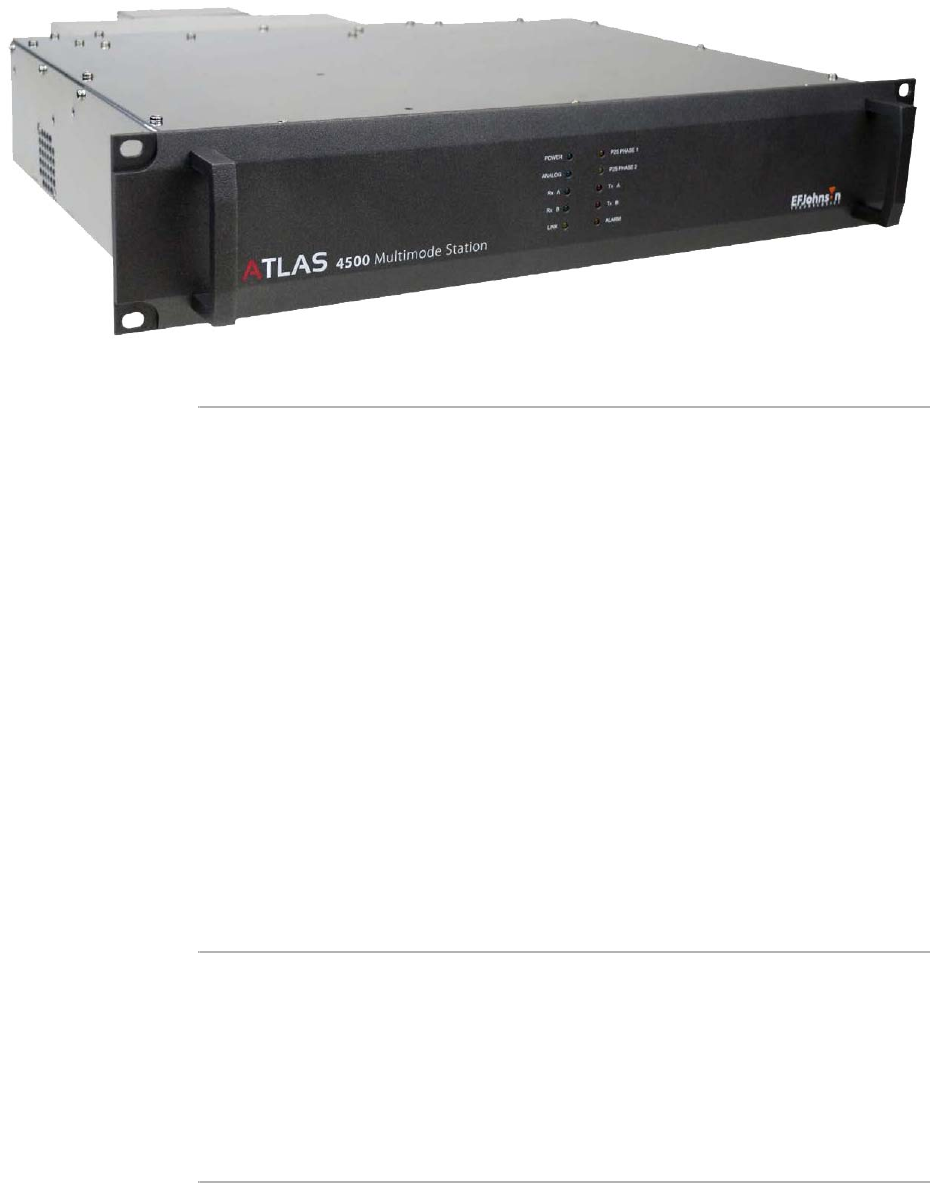
2-2 ATLAS 4500 Multimode Station Technical Manual December 2016
Functional Description Section 2 - Product Overview
Figure 2.1 ATLAS 4500 Introductory View
2.1.1 Architecture
• Leverages a common hardware platform to support the following:
- 12.5 kHz, 20 kHz, and 25 kHz Analog
- 12.5kHz FDMA P25 Phase I
- 6.25 kHz P25 Phase 2 TDMA
• Operates in the following modes:
- Analog/P25 Conventional
- P25 Trunked
- Simulcast
• Smallest P25 Phase 2 base station in the industry packaged in an ultra-compact
2RU size chassis maximizing rack space usage
• AC or DC power input
- AC power input can be 90-264 VAC
- DC power input can be 24-58 VDC
2.1.2 Usability and Maintainability
• Modular architecture allows flexible expansion of sites and seamless scalability
of the system.
• Interactive front panel design displays status and diagnostics for rapid
troubleshooting.
• Flexible software upgrades
2.1.3 Design and Performance
• Improved multi-band receiver design provides higher sensitivity along with very
high intermodulation immunity for congested prime site locations.
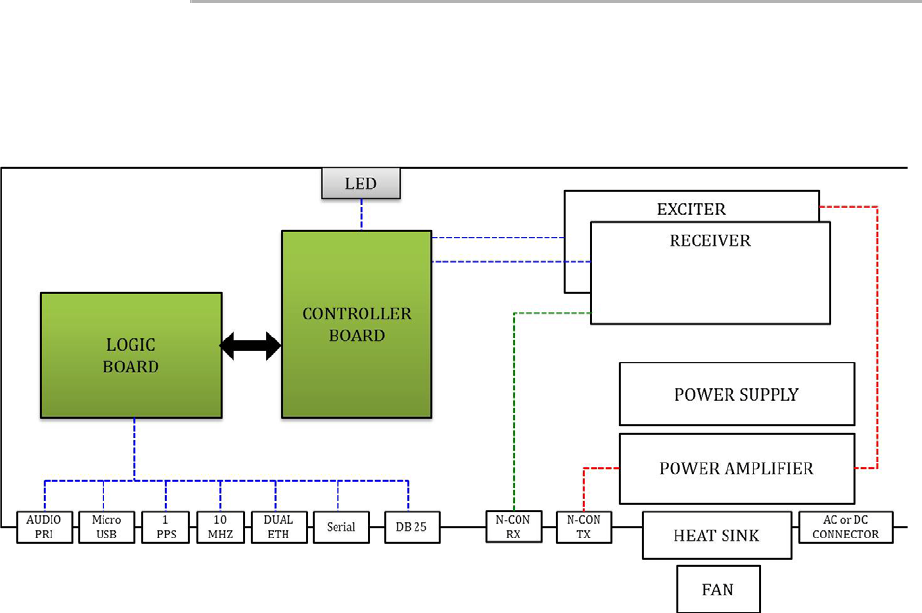
ATLAS 4500 Multimode Station Technical Manual December 2016 2-3
Hardware Description Section 2 - Product Overview
• High-power ultra linear ultra compact RF power amplifier uses digital and RF
techniques and components that greatly simplify operation
• Full-spectrum coverage in VHF, UHF, and 700/800 MHz
2.2 Hardware Description
This section contains information on the following topics:
• Block Diagram
• Front Panel Indicator LEDs
• Rear Panel Connectors
2.2.1 Block Diagram
The block diagram in Figure 2.2 shows the interconnection and communication
paths between ATLAS 4500 internal components.
Figure 2.2 Block Diagram
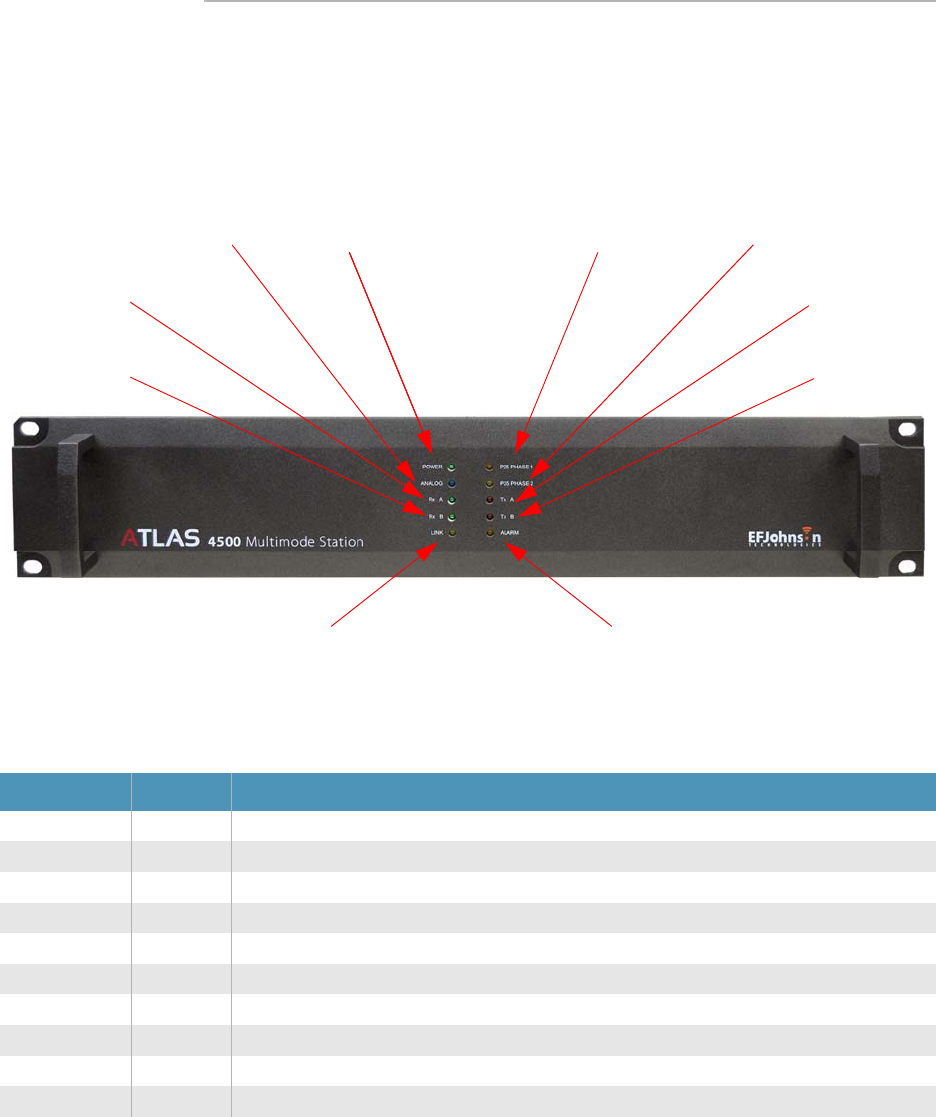
2-4 ATLAS 4500 Multimode Station Technical Manual December 2016
Hardware Description Section 2 - Product Overview
2.2.2 Front Panel Indicator LEDs
Figure 2.3 shows the ATLAS 4500 front panel. Table 2.1 contains descriptions of
the front panel indicator LEDs.
Figure 2.3 Front Panel
Table 2.1 Front Panel LEDs
LED Color Meaning (if on)
POWER Aqua Power is on
ANALOG Blue Station is operating in analog mode
Rx A Green Station is receiving in analog mode, P25 Phase 1 mode, or Slot 1 in P25 Phase 2 mode
Rx B Green Station is receiving in Slot 2 in P25 Phase 2 mode
LINK Yellow Link is up
P25 PHASE 1 Orange Station is operating in P25 Phase 1 mode
P25 PHASE 2 Yellow Station is operating in P25 Phase 2 mode
Tx A Red Station is transmitting in analog mode, P25 Phase 1 mode, or Slot 1 in P25 Phase 2 mode
Tx B Red Station is transmitting in Slot 2 in P25 Phase 2 mode
ALARM Orange There is an outstanding alarm
Rx A Tx A
P25 PHASE 1 P25 PHASE 2POWERANALOG
LINK ALARM
Rx B Tx B
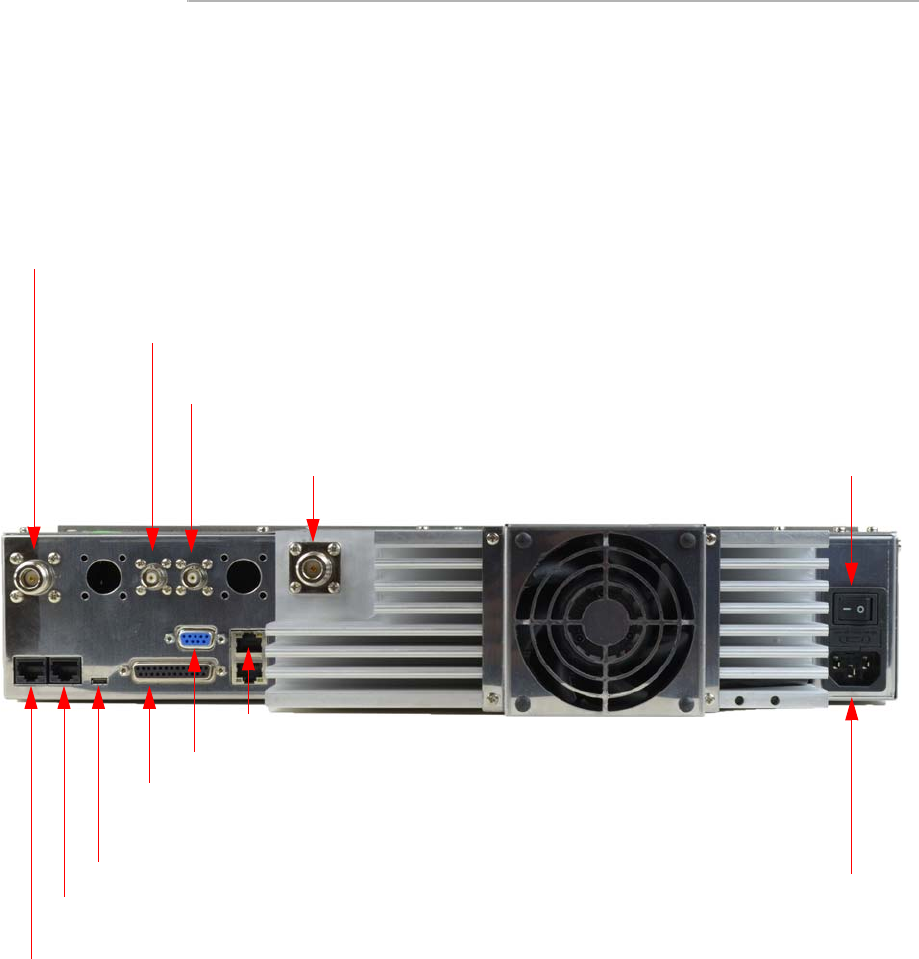
ATLAS 4500 Multimode Station Technical Manual December 2016 2-5
Hardware Description Section 2 - Product Overview
2.2.3 Rear Panel Connectors
Figure 2.4 shows the ATLAS 4500 rear panel and its connectors. Table 2.2 contains
descriptions of the connectors.
Figure 2.4 Rear Panel and Connectors
DB 25*
Connectors marked by * connect to the ATLAS 4500 logic card
N-Connector - Transmitter
Serial*
BNC Connector* - 10 MHz
Dual Ethernet*
Primary Audio*
Micro USB*
Power Switch
AC Power Connector
N-Connector - Receiver
BNC Connector* - 1 PPS
Wire/4 Wire E&M for Transmit and Receive
Secondary Audio* (not used)
4 Wire/4 Wire E&M for RX2
12 pins for Repeater I/O
13 pins for future use to be determined
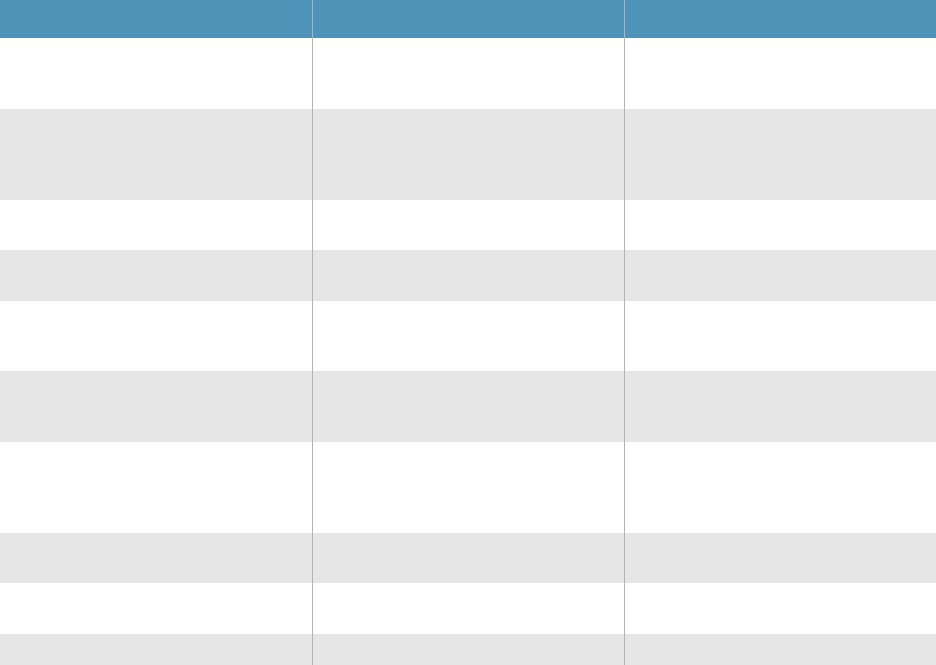
2-6 ATLAS 4500 Multimode Station Technical Manual December 2016
Software Description Section 2 - Product Overview
2.3 Software Description
Administrators use the ATLAS® 6100/6200 Network Management System (NMS)
to configure and maintain the ATLAS 4500. Refer to the ATLAS 6100/6200
Network Management System (NMS) Technical Manual.
2.4 Specifications
Table 2.3 summarizes ATLAS 4500 general specifications. Table 2.4 summarizes
ATLAS 4500 transmitter specifications. Table 2.5 summarizes ATLAS 4500
receiver specifications. Table 2.6 summarizes ATLAS 4500 standards compliance.
Table 2.2 Rear Panel Connectors
Connector Type Function
Primary Audio RJ 45 socket, 8 pin Primary 4-Wire/4-Wire E&M Connection.
Used to transmit over 4-wire or receive
over 4-Wire from the receiver
Secondary Audio RJ 45 socket, 8 pin
Not used (Secondary 4-Wire/4-Wire
E&M Connection. Designed to receive
audio over 4-wire from optional Receiver
2.)
BNC Connector - 1 PPS BNC (F) 1 pulse per second input from the GPS
receiver
BNC Connector - 10 MHz BNC (F) 10 MHz reference from the frequency
reference
Dual Ethernet Dual RJ47 Double stacked RJ 47 Ethernet
connector. Connects to the router/
switch.
Serial Serial (F) DB9 connector used to provide console
access to the logic card and the
controller board (for debugging, etc.)
DB 25 DB25 (F)
General purpose 25-pin connector. 12
pins to be used for Repeater I/O and 13
pins will be used for miscellaneous
functions.
N-Connector - Receiver 1 N(F)-Type N-Type connector to connect the
primary receiver to the multicoupler.
N-Connector - Transmitter N(F)-Type N-Type connector to connect the
transmitter to the isolator/combiner.
AC Power Connector IEC-60320-C14 Inlet AC power input
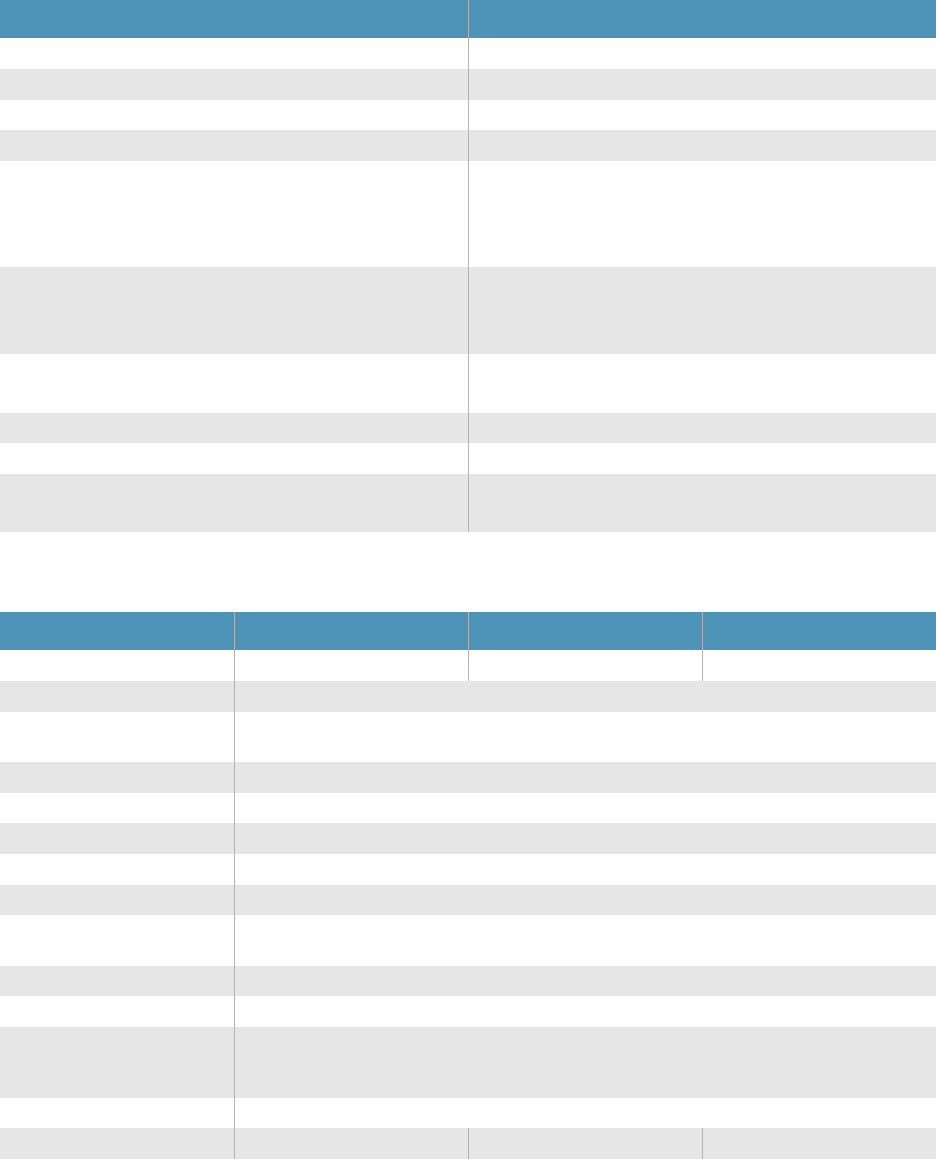
ATLAS 4500 Multimode Station Technical Manual December 2016 2-7
Specifications Section 2 - Product Overview
700/800MHz
Table 2.3 General Specifications
Parameter Values
Mounting 19” rack or shelf
Dimensions (Height x Width x Depth) 3.5" x 19" x 17.9" (89 x 483 x 455mm)
Weight 24.25 pounds (11 kg)
Operating Temperature Range -22°F to +140°F (-30°C to +60°C)
Power Requirements
AC: 90-264 VAC, 47-63 Hz
or
DC: 24-58 VDC
positive or negative ground
Power Consumption
100 W
Tx 430 W
Rx 28 W
RF Interconnects Tx: N Female
Rx: N Female
Channel Spacing 12.5 kHz
FCC Compliance Parts 15 and 90
Modulation TX: C4FM, H-DQPSK (Linear and Linear Simulcast)
RX: C4FM,H-CPM, FM
Table 2.4 Transmitter Specifications
Parameter VHF UHF 700 / 800 MHz
Frequency Range 136-174 MHz 380-520 MHz 763-776 MHz, 850-870 MHz
RF Power Output 1-100 Watts
Electronic Switching
Bandwidth Full Bandwidth
Duty Cycle 100%
Output Impedance 50
Spurious Emissions 90 dB
Harmonic Emissions 90 dB
Modulation Fidelity 3%
Intermodulation Attenuation 40 dB
80 dB With External Isolator
Audio Response As per TIA
Analog Audio Distortion 2%
Frequency Stability
[-22°F to +140°F
(-30°C to +60°C)]
1 PPM (Internal)
0.1 PPM (External Ref: GPS Synchronized)
Digital Emission Designator 8K10F1E, 8K10F1D, 8K10F7E
Analog Emission Designator 11K0F3E 11K0F3E 16K0F3E, 14K0F3E
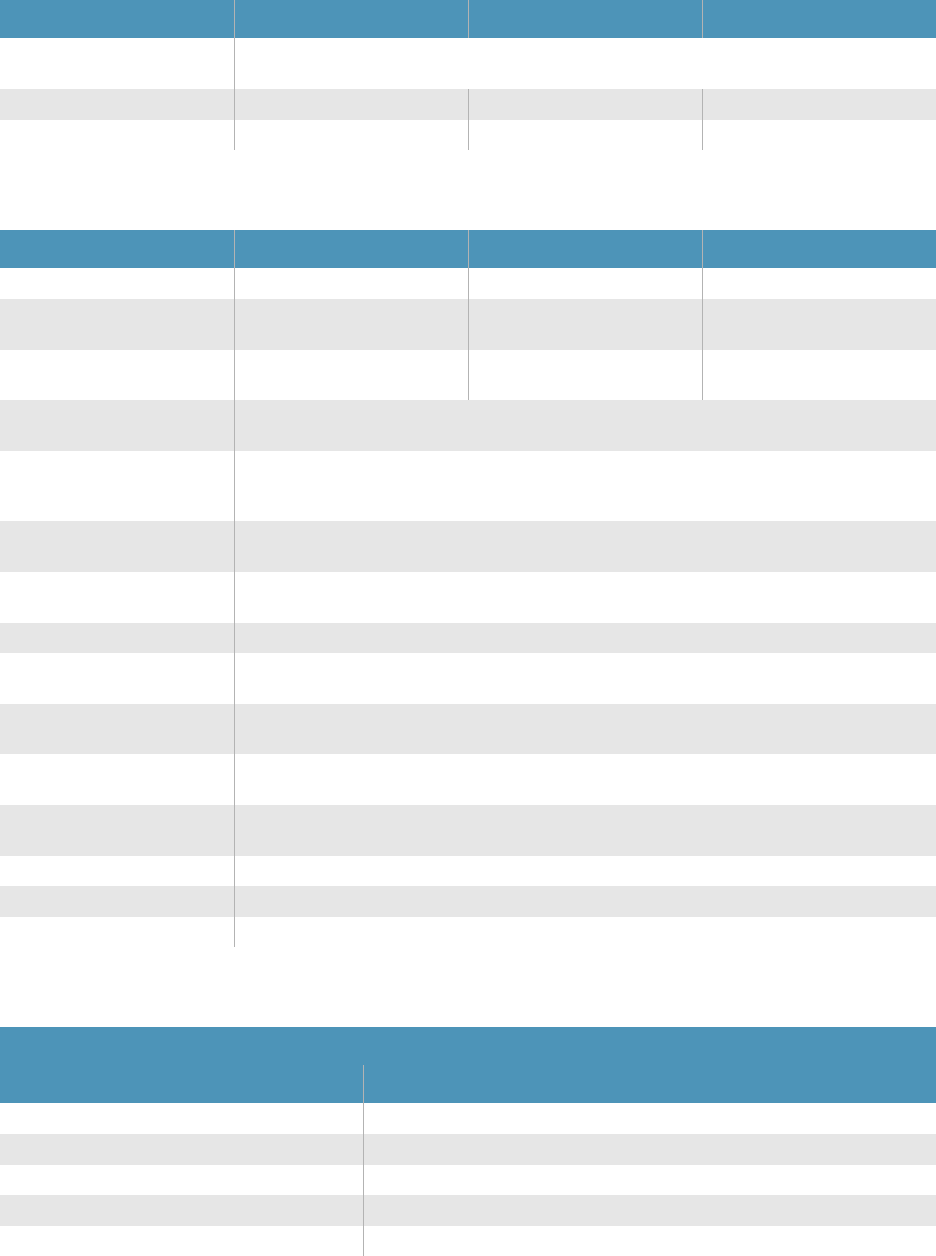
2-8 ATLAS 4500 Multimode Station Technical Manual December 2016
Specifications Section 2 - Product Overview
Analog FM Hum & Noise
(S/N Ratio) 45 dB
Maximum Deviation (Analog) ± 2.5 kHz ± 2.5 kHz ± 5 kHz
Maximum Deviation (Digital) ± 3110 Hz ± 3110 Hz ± 3110 Hz
Table 2.5 Receiver Specifications
Parameter VHF UHF 700 / 800 MHz
Frequency Range 136-174 MHz 380-520 MHz 792-825 MHz
Analog Sensitivity: 12dB
SINAD -119 dBm -119 dBm -119 dBm
Digital Sensitivity: for 5%
BER -119 dBm -119 dBm -119 dBm
Signal Displacement
Bandwidth ± 1 kHz
Frequency Stability
[-22°F to +140°F
(-30°C to +60°C)] 0.5 PPM
Analog Adjacent Channel
Rejection (TIA603D) 72 dB
Digital Adjacent Channel
Rejection 60 dB
Intermodulation Rejection 82 dB
Spurious and Image Response
Rejection 90 dB
Audio Response +1, -3 dB from 6 dB per octave de-emphasis
300-3000 Hz referenced To 1000 Hz at line output
Analog Audio distortion
(at 1000 Hz) 2%
Digital Audio distortion
(at 1000 Hz) As per TIA
Analog Hum & Noise (TIA) 45 dB
Digital Hum & Noise (TIA) As per TIA
RF Input Impedance 50
Table 2.6 Standards Compliance
EFJohnson stations comply with the following standard specifications
Standard Specification
P25 Digital Operation TIA-102.CAAB-D
Digital Phase 2 (TDMA) Operation TIA-102.CCAB-A
Analog FM Operation TIA 603-D
EMI/EMC NTIA Manual Chapter 5
PSTN Line Isolation FCC Part 68 (USA)
Table 2.4 Transmitter Specifications (continued)
Parameter VHF UHF 700 / 800 MHz

ATLAS 4500 Multimode Station Technical Manual December 2016 3-1
SECTION
Installation and Configuration
This chapter contains the following sections:
• Rack Installation
• Connections
• Initial Configuration
3.1 Rack Installation
EFJohnson performs all rack installation before delivering the ATLAS 4500 to the
customer. Refer to Section 6 for information on obtaining technical support and
service.
3.2 Connections
EFJohnson makes all ATLAS 4500 cable connections for the customer. Refer to
Section 6 for information on obtaining technical support and service.
3.3 Initial Configuration
EFJohnson performs all initial configuration before delivering the ATLAS 4500 to
the customer. Refer to Section 6 for information on obtaining technical support
and service.
3-2 ATLAS 4500 Multimode Station Technical Manual December 2016
Initial Configuration Section 3 - Installation and Configuration
Administrators use the ATLAS 6100/6200 Network Management System (NMS)
to configure and maintain the ATLAS 4500. Refer to the ATLAS 6100/6200
Network Management System (NMS) Technical Manual.

ATLAS 4500 Multimode Station Technical Manual December 2016 5-1
SECTION
Maintenance
The ATLAS 4500 contains no parts that the customer may maintain. Refer to
Section 6 for information on obtaining technical support and service.
5.1 Software Updates
Administrators use the ATLAS 6100/6200 Network Management System (NMS)
to perform software updates for the ATLAS 4500. Refer to the ATLAS 6100/6200
Network Management System (NMS) Technical Manual.
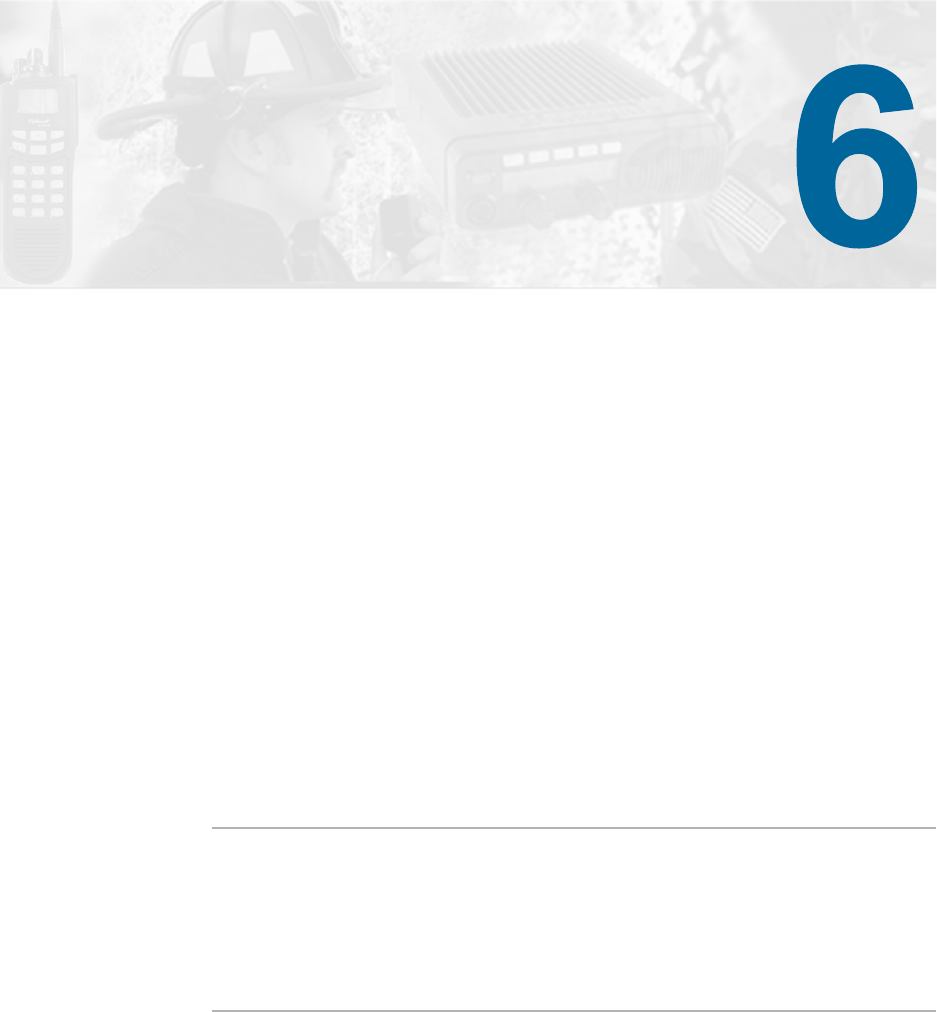
ATLAS 4500 Multimode Station Technical Manual December 2016 6-1
SECTION
Technical Support and Service
EFJohnson technical personnel are available to provide both onsite and online
service, in accordance with the existing support agreement.
6.1 Contacting EFJohnson
If EFJohnson Technologies technical personnel are not on site, and are needed for
installation assistance, contact the EFJohnson Technologies representative for
your site. Check with your site engineer or site manager for contact information.
6.1.1 Gather Information Before Calling EFJohnson
When contacting EFJohnson Technologies for technical support, collect and have
available all pertinent information such as specific site identification, equipment
models, and any other relevant information that may be needed by technical
support.
6.1.2 Contact Information
The Customer Service Department of EFJohnson Technologies provides customer
assistance on technical problems and the availability of local and factory repair
facilities. Regular customer service hours are 8:00 am–5:00 pm U.S. Central Time,
Monday–Friday. A technical support subscription service is available or support
can be purchased on an as-needed basis.
The Customer Service Department can be reached as detailed in Table 6.1.
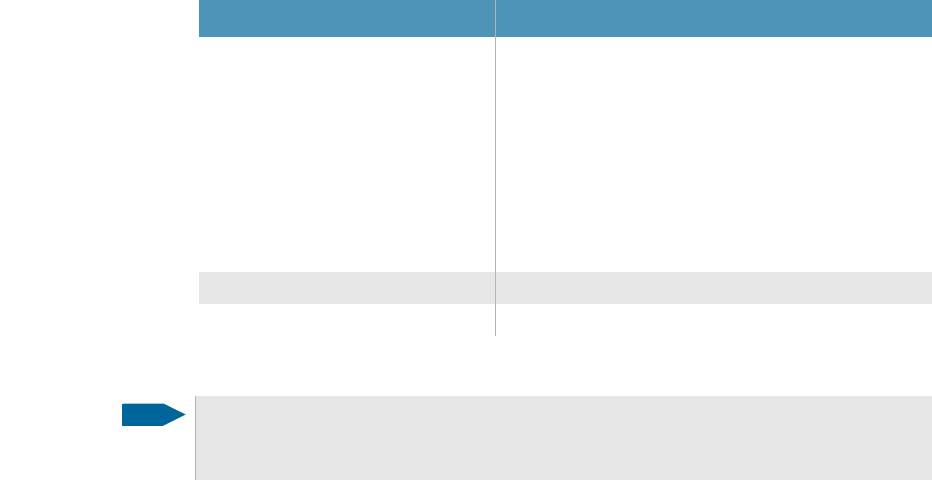
6-2 ATLAS 4500 Multimode Station Technical Manual December 2016
Product Warranty and Repair Section 6 - Technical Support and Service
You may also contact the Customer Service Department by mail. Please include all
information that may be helpful in solving your problem.
Customer Service Department
EFJohnson Technologies
1440 Corporate Drive
Irving, TX 75038-2401
6.2 Product Warranty and Repair
The warranty statement for EFJohnson equipment is available from your product
supplier or from:
Warranty Department
EFJohnson Technologies
1440 Corporate Drive
Irving, TX 75038-2401
(800) 328-3911
This information may also be requested from the Warranty Department by phone
(See Table 6.1.). The Warranty Department may be contacted for warranty service
reports, claim forms, or any other questions concerning warranties or warranty
service.
Table 6.1 Customer Service Contact Information
Method
Toll-Free Phone:
(800) 328-3911 (all except Multi-Net)
Extensions:
•Option #1: Orders and Parts
•Option #3: Technical Support
•Option #4: Repair Depot
•Option #5: Warranty, Support, Questions
(800) 295-1773 (Multi-Net only)
Fax: (972) 819-0851
Email: techsupport@efji.com
NOTE
During the warranty period and/or if you have a maintenance agreement, emergency 24-hour
technical support is also available at the preceding numbers during off hours, holidays, and
weekends.

ATLAS 4500 Multimode Station Technical Manual December 2016 6-3
Returns for Repairs Section 6 - Technical Support and Service
6.2.1 Online Product Registration
EFJohnson offers greater convenience through online product warranty
registration. Registering EFJohnson products online allows customers to receive
warranty service and field service notices more quickly.
To register EFJohnson Technologies products online and ensure the covered
warranty:
Step 1 In your browser, go to http://www.efjohnson.com/.
Step 2 Click the Service & Support link.
6.3 Returns for Repairs
Before returning equipment for repair, contact the EFJohnson Customer Service
Department at the appropriate number shown in Table 6.1. They may be able to
suggest a solution to the problem, making return of the equipment unnecessary.
Repair service cannot be performed by customers and is not available through local
authorized EFJohnson Technologies land mobile radio service centers. The
equipment must be returned to the EFJohnson Technologies Repair Depot.
However, before returning equipment, contact the Customer Service Department
Repair Depot for the correct “Ship To” address.
6.4 Replacement Parts
Replacement parts can be ordered directly from the Service Parts Department. To
order parts by phone, dial the toll-free number and select the Orders and Parts
extension specified in Table 6.1. When ordering, please supply the part number and
quantity of each part ordered. EFJohnson dealers also need to give their account
numbers. If there is uncertainty about the part number, include the designator
(C512, for example) and the model number of the equipment the part is from.
You may also send your order by mail or fax.
Service Parts Department
EFJohnson Technologies
1440 Corporate Drive
Irving, TX 75038-2401
Fax: (800) 328-3911
6-4 ATLAS 4500 Multimode Station Technical Manual December 2016
Internet Home Page Section 6 - Technical Support and Service
6.5 Internet Home Page
EFJohnson Technologies has an Internet site that can be accessed for information
on the company about such things as products, systems, and regulations. The
address is
http://www.efjohnson.com/

ATLAS 4500 Multimode Station Technical Manual December 2016 A-1
Appendix
Chapter 6UHF Circuit Descriptions
This chapter contains descriptions of the following UHF ATLAS 4500 internal
components. For each of the following components, this chapter contains a general
description and a schematic description:
• 380-520 MHz Exciter Module
• 380-520 MHz Receiver Module
• 380-520 MHz Power Amplifier
• Controller Board
•Audio Logic Board
• Power Supply
A.1 380-520 MHz Exciter Module
This section contains information on the following Exciter Module components:
• Frequency Synthesizers
• TX VCO Board
• Reference Clocks
• RF Carrier Generation & Modulation
• RF Filter Amp Section
• DPD Loop
• Exciter DC Supplies

A-2 ATLAS 4500 Multimode Station Technical Manual December 2016
380-520 MHz Exciter Module Appendix A - UHF Circuit Descriptions
A.1.1 General Description
The Exciter module generates the low level RF transmitter signal that is amplified
to nominal output power level by the Power Amplifier. The exciter module consists
of two circuit boards. A Voltage Controlled Oscillator (VCO) board and an RF
board with associated frequency synthesizers, a modulation controller, filtering
circuits and internal power supply circuits. Also included is circuitry for an error
loop system to improve transmitter linearity.
If an external frequency reference is desired, the exciter can be fed with an external
10 MHz signal. Otherwise it has an internal 10 MHz reference oscillator.
A.1.2 Schematic Description
A.1.2.1 Frequency Synthesizers
There are 4 synthesizers in the MDM Exciter: The main synthesizer, and 3
synthesizers used in the error loop section.
The Synthesizer O/P from the VCO board on SKU-1 is split to the dual fractional-N
synthesizer IC6 main divider input and the error loop first mixer LO amp IC16.
This signal is compared with the 10 MHz reference oscillator frequency and the
correction voltage from the synthesizer’s charge pump output is filtered then
amplified by the non-inverting low noise op amp IC10. This correction voltage is
fed back to the VCO to maintain loop lock as well as being fed to the Controller
through TX VCO VOLTS CN3-14. A lock detect signal from IC6 is also fed to the
Controller through TX LD CN3-16. The op amp IC10 uses a 25-V power supply
generated by IC4 to provide a wide tuning range voltage to frequency control
varicap diodes located on the VCO board. The VCOs power is supplied by a
dynamic filter TR6 and 8 V regulator IC11.
A serial flash IC47 contains synthesizer band, charge pump settings and
configuration data.
This is read by the Controller through the I2C bus to set the synthesizer.
Frequency programming data for the exciter is sent to Synthesizer IC6 from the
Controller through serial data (CN3-18) under the control of the Clock (CN3-15)
and Strobe (CN3-17) lines.
Synthesizer IC28 and associated components provide a reference of 345.6 MHz for
IC31 DDS IC. This 345.6 MHz signal is frequency locked to the 10 MHz main
reference clock. The 345.6 MHz clock is divided by 8 within IC31 and outputs a
43.2 MHz clock that drives IC32 FPGA.

ATLAS 4500 Multimode Station Technical Manual December 2016 A-3
380-520 MHz Exciter Module Appendix A - UHF Circuit Descriptions
Synthesizer IC24 and associated components provide a reference of 120.45 MHz
for the error loop second mixer LO amp IC21. This 120.45 MHz signal is frequency
locked to the 10 MHz main reference clock.
Synthesizer IC22 and associated components provide a reference of 40.32 MHz for
the MCLK line to the A/D IC 31. This 40.32 MHz signal is frequency locked to the
43.2 MHz FPGA ADLMX line.
A.1.2.2 TX VCO Board
The plug on VCO board consists of 4 band high Q inductor oscillators with a
common base oscillator for low phase noise. This is contained in a shielded
compartment in the case. The VCO provides frequencies over 499.64 – 639.64
MHz range in 4 bands.
The main RF VCO OUT on SKJ-6 is first buffered by a very high isolation circuit
consisting of the MMIC on the VCO, then on main board, a 3 dB pad and an
amplifier IC17. It is then down-converted at mixer X8 and used to generate the
main transmit RF amplifier signal source.
Each band is switched under control of the Controller. 2 MMIC buffers feed the
synthesizer and main outputs. The power supply to the VCO consists of an 8-V
regulator and active filter for maximum noise rejection located on the exciter PCB.
The 8-V supply consists of IC11, TR6 and associated components.
The PLL control line varies VCO frequency (SKT – 1).
A.1.2.3 Reference Clocks
A stable 10 MHz reference is generated by X1—a temperature controlled crystal
oscillator, and is fed to the synthesizer IC6 through select switch IC7. A detector
circuit senses the presence of an external 10 MHz reference > approximately 0 dBm
(0.6 Vpp) and informs the Controller through EXT REF DET CN3 – 10. IC7
switches between this internal oscillator and an external 10 MHz reference source
fed into CN4 under control of the Controller through EXT OSC SW CN3-13.
Buffer transistors TR2 and TR3 provide a fast slew rate clock REF IN for better
phase noise. This feeds a digital buffer IC 29 generating a fast edge 10MHz clock
for the 345.6 MHz and 120.47 MHz synthesizers.
There is a time delay to re-initialize the exciter after changing from internal to
external clock or external to internal clock, due to synthesizers needing re-
programming by the controller.
NOTE
An external 10 MHz clock must have low phase noise/jitter and have a nominal level of 10 dBm
(1.8 Vpp)
A-4 ATLAS 4500 Multimode Station Technical Manual December 2016
380-520 MHz Exciter Module Appendix A - UHF Circuit Descriptions
A.1.2.4 RF Carrier Generation & Modulation
RF carrier modulation type Phase 1 FM or LSM and Phase 2 H-DQPSK is
generated within IC31 FPGA and IC32 DDS from a serial digital stream on the I2S
bus lines coming from the external digital signal processor (DSP) and fed into Pins
5, 7 and 8 of CN3. The initial setup for the FPGA internal Arm controller is done
through the I2C bus on Pins 9 and 12 of CN3. The ARM controller inside the
FPGA IC has a 20 MHz crystal clock and internal VCO.
The FPGA provides raised cosine filtering of the I/Q data and is sent in digital form
to the DDS digital I/Q modulator. The DDS IC generates a differential 119.64 MHz
I/Q modulated signal. This is filtered by the SAW filter F5 into the high level mixer
X8 input.
The VCO output signal is mixed with the 119.64 MHz modulated signal by mixer
X8 (O/P of approximately -23 dBm) at the desired transmitter output frequency.
A.1.2.5 RF Filter Amp Section
The RF output of the mixer X8 is fed through the first RF band pass filter, then the
first MMIC amp, then the second RF band pass filter, and finally the second MMIC
amp before being output to the Power Amplifier module through CN1.
The 380 - 520 MHz band pass filter function is supplied by selectable bands. 4
bands are fitted as standard 380 – 415 MHz, 415 – 450 MHz, 450 - 485 MHz and
485 – 520 MHz.
Each first band pass filter I/P is fed by Switch IC20, then the filter output into
Switch IC18 to make up a selector circuit that switches the frequency band
programmed by the controller, followed by first MMIC amp IC2, and then a fixed
attenuator.
Each second filter I/P is fed by Switch IC26, then the filter output into switch IC19,
for the frequency band of operation. Then a notch filter and the second RF MMIC
amp IC23 providing gain to give an approximately 13 dBm output level.
A.1.2.6 DPD Loop
The modulator includes a Digital Pre Distortion (DPD) feedback system that
corrects for distortion in the PA and allows for small adjustments to be made to the
modulated RF signal output. This enables excellent overall linearity and good close
in ACP performance for the transmitter.

ATLAS 4500 Multimode Station Technical Manual December 2016 A-5
380-520 MHz Exciter Module Appendix A - UHF Circuit Descriptions
The feedback signal from the Power Amplifier sample port comes into the exciter
module through CN6 at approximately 3 dBm. This is attenuated then down-
converted with the main VCO output (499.64—639.64 MHz) from buffer amp
IC16 by mixer M1 to provide an output of 119.64 MHz. This passes through a 150
MHz low pass filter and is amplified by IC15.
The 119.64 MHz IF is down-converted with the 120.45 MHz local signal from
buffer amp IC21 by mixer M2 to result in an 810 KHz IF signal.
The local oscillator for this second down converter is provided by the 120.45 MHz
Synthesizer IC24 and associated components. Programming for this is provided by
the FPGA IC32.
The 810 KHz IF signal is band pass filtered and then amplified by a 20 dB gain
differential amplifier IC14, then further amplified by the 16 dB gain differential
amplifier front end of IC31, a high performance Analog-to-Digital converter.
This IF signal is sampled at a 20.16 MSps rate, then passed through an 810 kHz
digital FIR band pass filter inside IC31, BW is approximately 100 kHz and
decimated by 8 for a 2.5 MSps O/P rate.
The 16 bit digital samples from IC31 are read by IC32, the main FPGA/ARM for
processing by internal software. An area for pre-distortion correction tables is
provided by IC27 RAM. The FPGA DPD filter data is stored in the serial Flash
ROM IC35.
Inside the FPGA IC the 2.52 MSps 810 kHz IF is decimated by 7 to effectively give
a 1/9 converted 360 MSps 90 kHz signal plus other unwanted signals. This is then
passed though a narrow 90 kHz IF band pass FIR filter to removing other products
and noise.
The correction software in the FPGA/ARM has a short initial delay acquisition
followed by I/Q correction. This allows corrections to reduce overall distortion
products at the PA output.
A.1.2.7 Exciter DC Supplies
The exciter is supplied a nominal 13.8 V through CN3-2. This input supply is then
distributed to IC1, IC4, IC9 and IC11.
IC1 is configured as a 1 MHz buck DC-DC converter and provides the main
regulated +5.2 VDC output. A shielded inductor is used to reduce fields.
NOTE
The sample port CN2 provides a -6 dB sample of one side of the final differential analog O/P of
the 810 kHz IF at approximately a -10 dBm level.

A-6 ATLAS 4500 Multimode Station Technical Manual December 2016
380-520 MHz Receiver Module Appendix A - UHF Circuit Descriptions
IC9 is configured as a boost DC-DC converter and provides +25 V DC output for
the main PLL.
IC3 is a linear regulator regulating the +5.2 V supply down to +5 VDC for linear
circuits, A/D, RF amps etc.
IC30 and IC48 are linear regulators regulating the +5 V supply down to +3.3 V DC
for the synthesizers.
IC33 contains multi-circuit buck DC-DC converters and low drop out regulators
that provide +3.3 V, +2.5 V, +1.8 V and +1.2 V for various circuit sections in the
digital portion of the exciter including the FPGA, memory and DDS etc.
A.2 380-520 MHz Receiver Module
This section contains information on the following Receiver Module components:
• Frequency Synthesizer
• RX VCO Board
• Reference Clock
•Front End
• 90 MHz IF Section
• Receiver DC Supplies
A.2.1 General Description
The receiver module converts a low level RF signal from an antenna input to a 90
MHz intermediate frequency (IF) output for processing with the DSP RX board.
Low side injection is used in the upper 2 bands, high side injection in the 2 lower
bands. The module has a 30-W interface and 2 SMB connectors for RF input and
90 MHz IF output.
The receiver module consists of two circuit boards: A Voltage Controlled
Oscillator (VCO) board and an RX board with associated frequency synthesizers,
down converter, TCXO, filtering circuits and internal power supply circuits.
Receiver input frequency programming is achieved by using serial data connections
to an external controller. A serial flash IC contains synthesizer band, charge pump
settings and configuration data read by the Controller.

ATLAS 4500 Multimode Station Technical Manual December 2016 A-7
380-520 MHz Receiver Module Appendix A - UHF Circuit Descriptions
A.2.2 Schematic Description
A.2.2.1 Frequency Synthesizer
RF is output from the VCO board on SKU2-1. It gets applied to the fractional-N
synthesizer IC6 main divider input. This signal is compared with the reference
oscillator frequency and the correction voltage from the synthesizer’s charge pump
output, which is filtered then amplified by the non-inverting low noise Op Amp
IC10. This correction voltage is fed back to the VCO to maintain loop lock. The
VCO control voltage is also buffered and sent to the Controller through on RX
VCO VOLTS (SK1-14). The op amp uses a 25-V power supply generated by IC4
to provide a wide tuning range voltage and good phase noise-to-frequency control
varicap diodes located on the VCO board.
A second RF output from the VCO on SKT2-6 is mixed with the incoming RF and
generates an IF output of 90 MHz at CN2. This VCO signal is first buffered by a
very high isolation circuit consisting of a MMIC on the VCO and a 1dB pad and an
amplifier (IC17) at 22 dBm.
Frequency programming data for the exciter is sent to IC6 from the Controller
through a serial data (SK1-18), Clock (SK1-15), Strobe (SK1-17). A lock detect
signal from IC6 is also fed to the Controller through RX LD (SK1-16).
A.2.2.2 RX VCO Board
The plug on VCO board consists of 4 band high Q inductor oscillators with a
common base oscillator for low phase noise. This is contained in a shielded
compartment in the case. The VCO provides frequencies in 4 bands: 2 are for 90
MHz low side injection, and 2 are for 90 MHz high side injection. The bands are
• 375 – 405 MHz
• 405 – 430 MHz
• 470 – 525 MHz
• 525 – 555 MHz.
The main RF VCO OUT on SKJ-6 is first buffered by a very high isolation circuit
consisting of the MMIC on the VCO, then on the main board, a 3 dB pad and an
amplifier IC17. It feeds LO to mixer X8 used to down-convert the RX signal to a 90
MHz IF signal.
Each band is switched under control of the Controller. 2 MMIC buffers feed the
synthesizer and main outputs. The power supply to the VCO consists of an 8-V
regulator and active filter for maximum noise rejection located on the exciter PCB.
The 8-V supply consists of IC11, TR6 and associated components.
The PLL control line varies VCO frequency (SKT – 1).
A-8 ATLAS 4500 Multimode Station Technical Manual December 2016
380-520 MHz Receiver Module Appendix A - UHF Circuit Descriptions
A.2.2.3 Reference Clock
A stable 10 MHz reference is generated by X1—a temperature controlled crystal
oscillator (TCXO), and fed to the synthesizer IC6 through an amplifier consisting
of TR2 and associated components.
A.2.2.4 Front End
The incoming signal from the antenna is connected to CN1, where it passes through
a low pass filter, then a limiter before amplification by IC2 (which can be linked
out for higher dynamic range). After IC2 the signal is fed to a band pass filter
network switched by IC19 and IC26. From here, the signal is amplified by IC34
and fed into another band pass filter network with the band in use switched by IC18
and IC20. ICs 18, 19 20 & 26 are controlled from the external Controller through 4
digital logic signals that select the correct filters for the frequency sub-band in use.
The 4 band pass filter switches use 4 lines (SK1 – 19), (SK1 – 20), (SK1 – 21),
(SK1 – 22)
A.2.2.5 90 MHz IF Section
A VCO signal generated by the synthesizer is fed into a RF mixer (X8) where it
produces a fixed frequency output of 90 MHz. This IF output is then fed through an
input matching network through a crystal filter (FL7) and associated output
matching network and is then amplified further by IC49 and associated
components. The IF signal is filtered further by crystal filters FL8A and FL8B and
their matching networks before being amplified further by TR8 and associated
components. The 90 MHz filtered IF output is fed for external signal processing in
the DSP RX board through connector CN2.
(The 90 MHz IF O/P level is approximately -53 dBm for -100 dBm RX I/P and
approximately -13 dBm for -60 dB RX I/P at 800MHz)
A.2.2.6 Receiver DC Supplies
The exciter is supplied nominal 13.8 V through SK1-2. This input supply is then
distributed to IC1 and IC4.
IC1 is configured as a buck DC-DC converter and provides a regulated +5.2 VDC
output.
IC4 is configured as a boost DC-DC converter and provides +25 V DC output.
IC3 regulates +5.2 V supply down to +5 VDC.

ATLAS 4500 Multimode Station Technical Manual December 2016 A-9
380-520 MHz Power Amplifier Appendix A - UHF Circuit Descriptions
IC48 regulates +5 V supply down to +3.3 VDC.
A.3 380-520 MHz Power Amplifier
This section contains information on the following Power Amplifier components:
• Attenuator
• Driver Module
• Output Power Amp
•Power Coupler
• Power Detector
• Harmonic Filter
• PTT Power Control
• Auxiliary Circuits
A.3.1 General Description
The PA contains the following components
• Variable attenuator
• Driver module
• Main power amp
• Cooling system and heat sensor
• Coupler for DPD system.
• Power detector
• Low pass filter
• PTT switch
• Serial flash memory and regulator
A.3.2 Schematic Description
A.3.2.1 General
The RF input is approximately 12 dBm into CN1. The PA provides 1-100 W output
across 380 – 520 MHz band at the main N type connector. The Main supply is 48V
at < 10A at CN3. The secondary supply is 24 V at 450 ma at CN2, and 5 V at 10 ma
at CN2.

A-10 ATLAS 4500 Multimode Station Technical Manual December 2016
380-520 MHz Power Amplifier Appendix A - UHF Circuit Descriptions
A.3.2.2 Attenuator
CN1 at approximately12 dBm enters attenuator IC1. This provides attenuation
steps of 0.25 dB from a 2 dB minimum. This is used by the Controller for power
control through CN2 pins 3, 4, 5 lines.
A.3.2.3 Driver Module
The attenuator IC feeds an amplifier module IC2 to provide drive for the main PA
amp.
This module is a high linearity low intermodulation 75-Ω power driver with
approximately24 dB gain, 28 dBm RF power. It operates at 24 V at 450 ma.
A.3.2.4 Output Power Amp
The PA output power amp stage uses a high performance power FET in a Gemini
package. This is mounted on a copper heat spreader plate, on a fan-cooled
aluminium heat sink.
The input matching uses a 90° section 17-Ω transmission line balun loaded with
ferrite to prevent oscillations. Then, a balanced matching section gives
approximately 0.5-Ω Zin FET.
Input series resistors and a parallel resistor are used to prevent instability.
The output match from approximately 6 Ω Zout consists of a 2-section match, then
to a 90° section 17-Ω transmission line balun to give 50-Ω feed.
Due to use of open long balun there is high Q resonance for second harmonics at
one frequency area. A power absorber network for approximately900 MHz reduces
amplitude of second harmonics on FET drains and gives better intermodulation of
the PA.
A.3.2.5 Power Coupler
The PA feeds an output RF coupler port, providing about 3 dBm at 100 W output.
This is for DPD use, and is fed to the Exciter.
NOTE
The Controller uses the PA calibration data stored in IC11 during PA calibration, FWD VOLTS
from the power detector, TX frequency and O/P power settings set from the DSP to control the
attenuator values dynamically.

ATLAS 4500 Multimode Station Technical Manual December 2016 A-11
Controller Board Appendix A - UHF Circuit Descriptions
A.3.2.6 Power Detector
Next, the output RF passes a directional coupler. This is used to sense PA forward
and reflected power. The FWD VOLTS goes to CN – 11. REFL VOLTS goes to
CN – 12.
Detector sensitivity gives approximately 3.5 V at 100 W at the center of the band.
A.3.2.7 Harmonic Filter
Next follows a 4-stage elliptical low pass filter inside a screened cover. This
provides attenuation of all harmonics.
A.3.2.8 PTT Power Control
The PTT line from CN – 8 controls the Switch TR2. This switches 24 V and allows
PA FET bias to operate. PA bias is nominally set for 4 V at CN2 – 7 and pot-
adjusted for approximately3 A.
A.3.2.9 Auxiliary Circuits
The PA contains a 3.3-V regulator IC7 with 5 V in from CN2-14, a temperature
sensor TS1 on CN2 – 13, and a serial flash IC11 using I2C bus on CN2- 9, 10.
A.4 Controller Board
This section contains information on the following Controller Board components:
• PA Interface
• Exciter Interface
• RX Interface
• DSP Interface
• Fan Control
• External Port and Serial Links
• Auxiliary
•Firmware
NOTE
A harmonic filter network is added to keep response flat.

A-12 ATLAS 4500 Multimode Station Technical Manual December 2016
Controller Board Appendix A - UHF Circuit Descriptions
A.4.1 General Description
The Controller PCB contains the following:
• The main microcontroller IC1 containing CPU, flash, RAM, UARTs, ports etc
•Data latches
• Serial Flash
• 3.3-V and 5-V linear regulators
• Power on reset IC
•PA I/F, etc
• Control /noise filter for the fan in the PA
• 10 MHz osc det I/P used for 10 MHz ref switch control in the Exciter
• DSP I/F port
• Exciter I/F port
• Receiver I/F port
•Relay O/P
• LED I/F
• Configuration links
A.4.2 Schematic Description
A.4.2.1 PA Interface
The interface has 14 pins. The PA interface provides 24 V 450 mA and 5 V 10 mA.
It controls the PA by means of the PTT line and the bias line [nominally 4 V at
77°F (25°C)].
The forward power and reverse power detector voltages are transferred to the
controller. The PA copper plate temperature can be read through a single pulse
width modulation line.
During power up, the Controller loads the PA calibration data from the Serial flash
IC on the I2C bus. This bus is also used for initial PA calibration.
A.4.2.2 Exciter Interface
The Exciter interface has 30 pins. The Exciter interface provides
approximately13.8 V at approximately0.6 A. The interface includes:
• Synth – 4 x Lines are provided for 4 VCO controls, 3 x synth frequency setting
lines, lock alarm.
ATLAS 4500 Multimode Station Technical Manual December 2016 A-13
Controller Board Appendix A - UHF Circuit Descriptions
• I2C bus for exciter serial flash and FPGA ARM communication from the
Controller
• TXVCO volts monitor line. Exciter PTT line from the Controller,
• The main data stream using 3 x I2S data communication lines from DSP, 2 Serial
data lines from the Controller board for diagnostic use.
• 1 pps line to FPGA for similcast.
• FPGA PTT, FPGA TP G line, FPGA TP H line (initially used).
• The Controller can sense the presence of external 10 MHz reference
(>approximately0 dBm 0.5 Vpp) using Ex ref line. The Controller can select
External reference using Ext osc sw line. This is done by software control to
allow correct handover.
A.4.2.3 RX Interface
There are RX interfaces for 2 receivers. This allows a second diversity RX option.
The RX connector is a 30-pin connector. Most lines are common for both. This
includes 12-V and 3.3-V supplies, I2C bus for the serial flash used for synthesizer
band selection and PLL gain.
The Controller sets the channel frequency through the common PLLDAT and
PLLCLK and RX1 EN and RX2 EN lines. Each of the 2 VCO bands is selected by
means of 2 VCO band lines. Each RX VCO control voltage can be monitored on
each RX1VCO and RX2VCO line.
A.4.2.4 DSP Interface
The DSP overall controls the base station.
The DSP control serial data (RS232) communication is sent to the Controller using
a protocol. This controls modulation mode, channel frequency, power etc. The
Controller then sends I2C to the Exciter and logic for PTT, sets PA power etc.
The DSP TX modulation data is sent synchronously through the I2SCLK, I2SDAT,
ISFRM lines to the Exciter FPGA. The FPGA controls the clock and frame timing
of this interface, where DSP provides raw data. A 1-pps signal from the DSP can be
provided for precise simulcast timing.
The DSP RX IF comes from the RX to DSP. The main RX1 and optional RX2 90
MHz IF signals are fed directly from the receivers to the DSP section RX sub board
through coax cables from CN2.
A-14 ATLAS 4500 Multimode Station Technical Manual December 2016
Controller Board Appendix A - UHF Circuit Descriptions
A.4.2.5 Fan Control
The PA fan interface has 4 pins. 12 V Power is switched with a pulse width FET.
Fan power noise spikes are attenuated by RFI network using L1 etc to eliminate
noise on 12 V power.
A speed control is provided for the fan. A pulse RPM sensor allows RPM to be
measured.
A.4.2.6 External Port and Serial Links
The Controller PCB has an external 10-pin port for diagnostic use with jumper
links JMP2 and JMP3 to select Debug access to MCU position A. Debug access to
Exciter position C.
The Controller can be talked to in position A of links JMP2 and JMP3 to its serial
port 2 and debug or loader program used. (To use the loader JMP1 must be taken
off)
The DSP I/F normally accesses controller serial port 1 but when DSP is not
connected this can also be selected using links JMP4 and JMP5 Position B.
(normally always A).
A.4.2.7 Auxiliary
The Controller PCB has 2 x 3.3 V linear regulators and a 5-V linear regulator.
It contains an interface for the 10 front panel LED indicators. (some future use)
These are for Power, Analog, RXA, RXB (diversity), Link (Ethernet on), P25
phase 1 (C4 FM), P25 phase 2, TX A (time slot A), TX B (time slot B).
The CPU A/D inputs monitor voltages for Supply in (48 V), RX VCO 2, RX VCO
1, TX VCO, Forward and Reflected voltages.
The Controller sends serial data on 3 lines to the PA 7 bit attenuator ATN1, ATN2,
ATN3 for SI, CLK, LE pins on the attenuator IC.
The Controller has an input port for the temperature sensor sending a pulse width
modulated signal.
A.4.2.8 Firmware
The Controller flash contains the following:

ATLAS 4500 Multimode Station Technical Manual December 2016 A-15
Audio Logic Board Appendix A - UHF Circuit Descriptions
• Gateway operational software to obey command protocol from the DSP. DSP
sends commands to set up RF characteristics, modulation etc.
• PA power control software and temperature sensing. Fan control.
• Debug software to allow control through the PC terminal program.
• Alarm points and monitors alarms and takes corrective action
• Controls interfaces with Exciter for frequency setting and PTT indication
• Controls EEPROM reading and writing from various modules. Allows it to be
controlled from the Debug point initially. Later DSP can select.
• Configuration data, serial number etc. Plug and play system for all modules.
Reads config data from all modules.
• Other operational software.
A.5 Audio Logic Board
A.5.1 General Description
The Audio Logic board is the main controller for the base station.
It sends and receives serial control to the Controller using a defined protocol.
It communicates data with the Ethernet link receiving and sending data to its
network.
The TX data encoding, modulation shaping, RX clock recovery, demodulation etc
is done by the hardware and programming.
The TX modulation data is sent synchronously through the I2SCLK, I2SDAT,
ISFRM lines to the Exciter through the Controller board.
The RX modulation is through 90 MHz IF ports, main and diversity.
A.5.2 Schematic Description
The OMAP operates all external interfaces and the three serial communication
devices. It also interfaces with the Controller board through a MCBSP BUS and
UART.

A-16 ATLAS 4500 Multimode Station Technical Manual December 2016
Power Supply Appendix A - UHF Circuit Descriptions
A.6 Power Supply
This section contains information on the following Power Supply components:
• Mains-to-48V PSU
• Filters
• Switch Mode DC-to-DC Convertors
A.6.1 General Description
The base station main power supply contains the following:
• 100 – 240 VAC-to-48 VDC supply
• Mains Filter, 48 V I/P and 3 O/P Filters.
• DC to DC 5.2 V PSU
• DC to DC 13.8 V PSU
• DC to DC 24 V PSU
• Cable and connector to main Controller PCB and PA.
• Shielded case
A.6.2 Schematic Description
A.6.2.1 Mains-to-48V PSU
The base station uses a switch mode power supply 100 – 240 VAC input, 48 V 10.5
A, 500 W output. This has a temperature controlled cooling fan inside.
A.6.2.2 Filters
The General power supply board has an EMI filter of the AC mains (inside PSU)
and filter networks on the 48 V DC O/P for ripple and RFI noise.
The 3 DC to DC convertors outputs have filter networks to filter RFI noise.
A.6.2.3 Switch Mode DC-to-DC Convertors
The 48V supply is DC / DC converted to 5 V by IC2, 13.8 V by IC1 and 24 V by
IC3.


